The Spread of Writing
October 12, 2022 • #The spread of written language around the world, from Egyptian hieroglyphics to today.
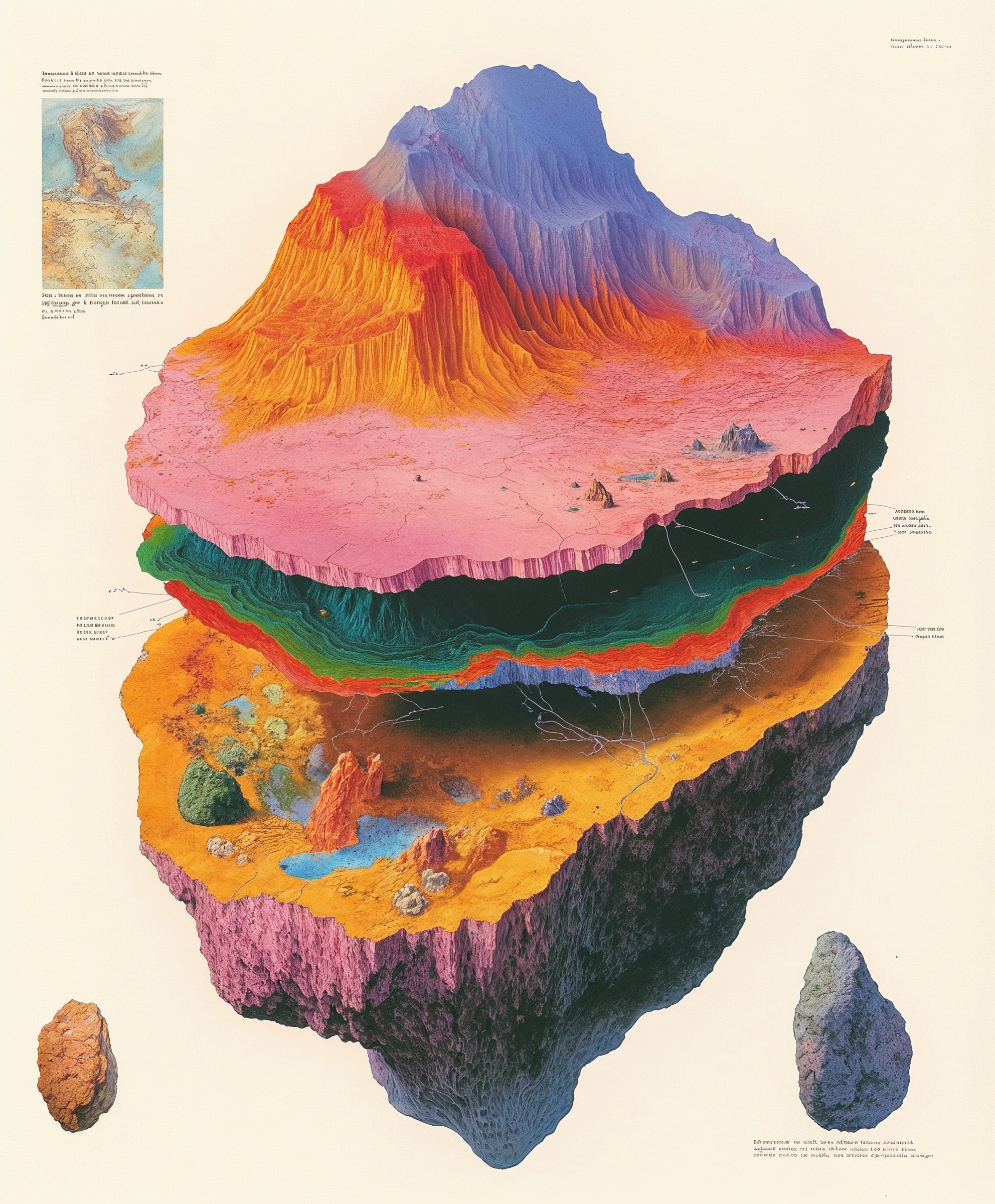
“Topographic beauties straight from old geography books”, @egeberkina.

New York and Erie Railroad diagram, 1855.
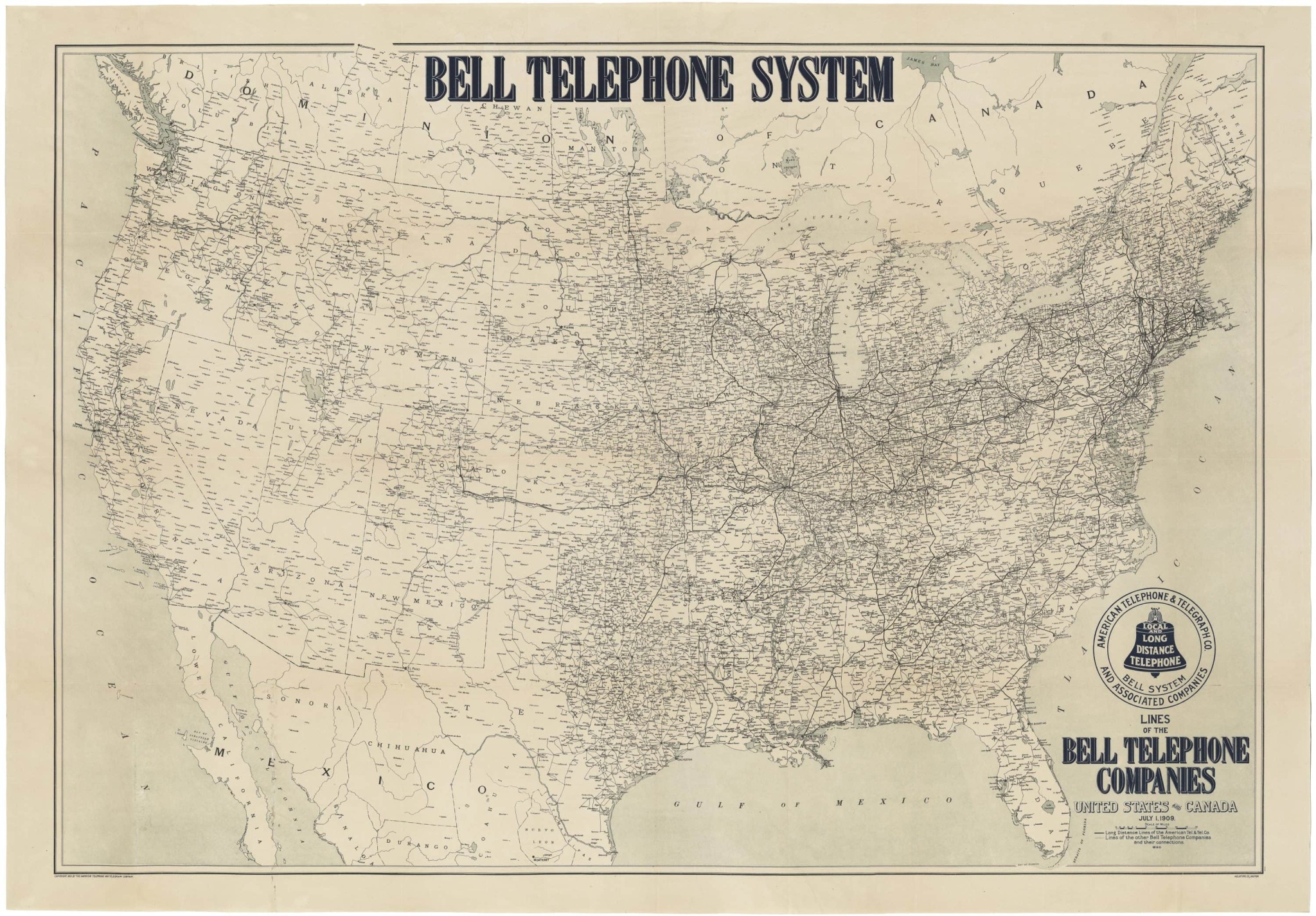
Map of the Bell Telephone System , 1909.

The Yukon River delta , Alaska.
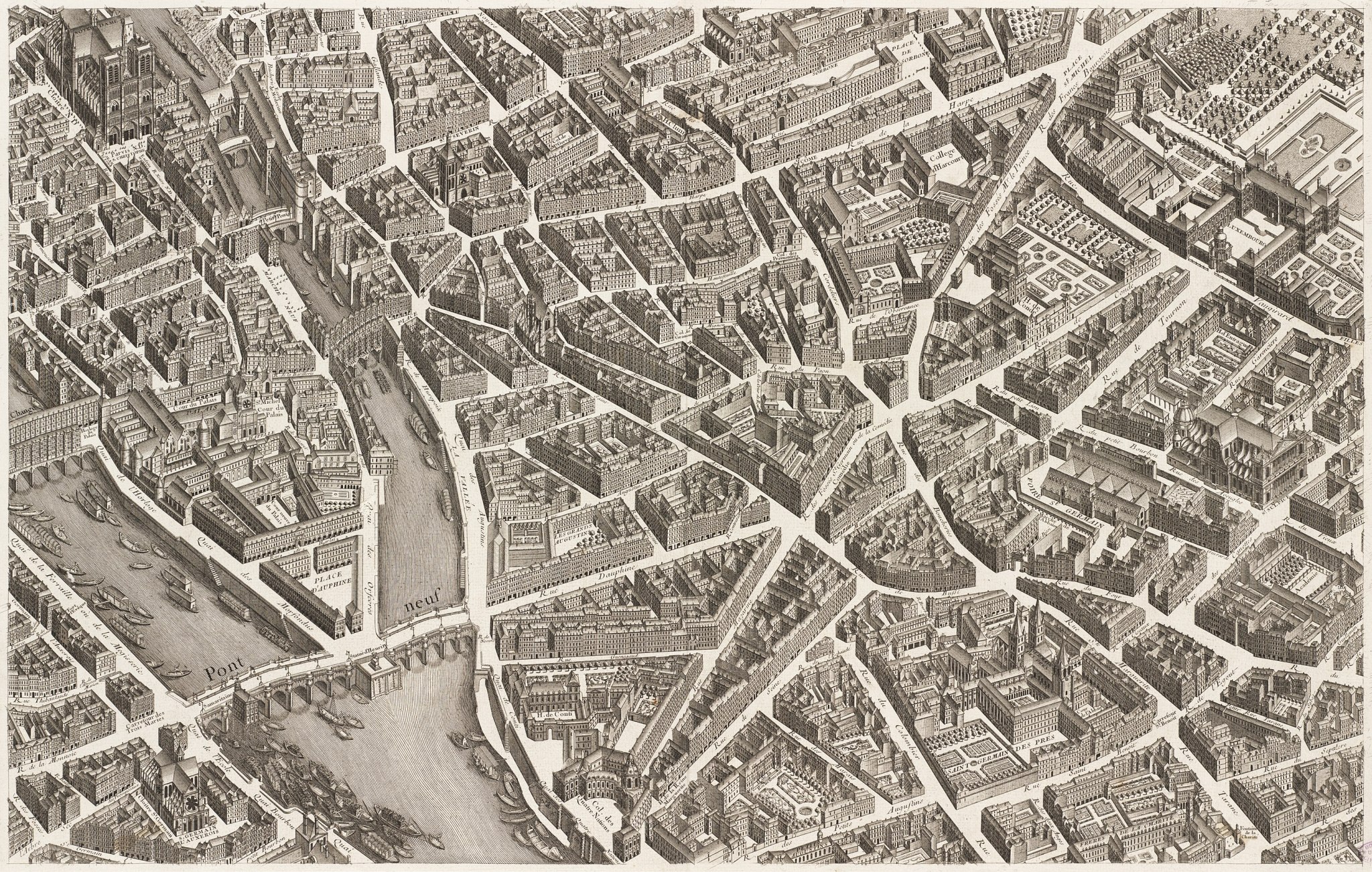
Map of Paris by Michel-Étienne Turgot. 1739.
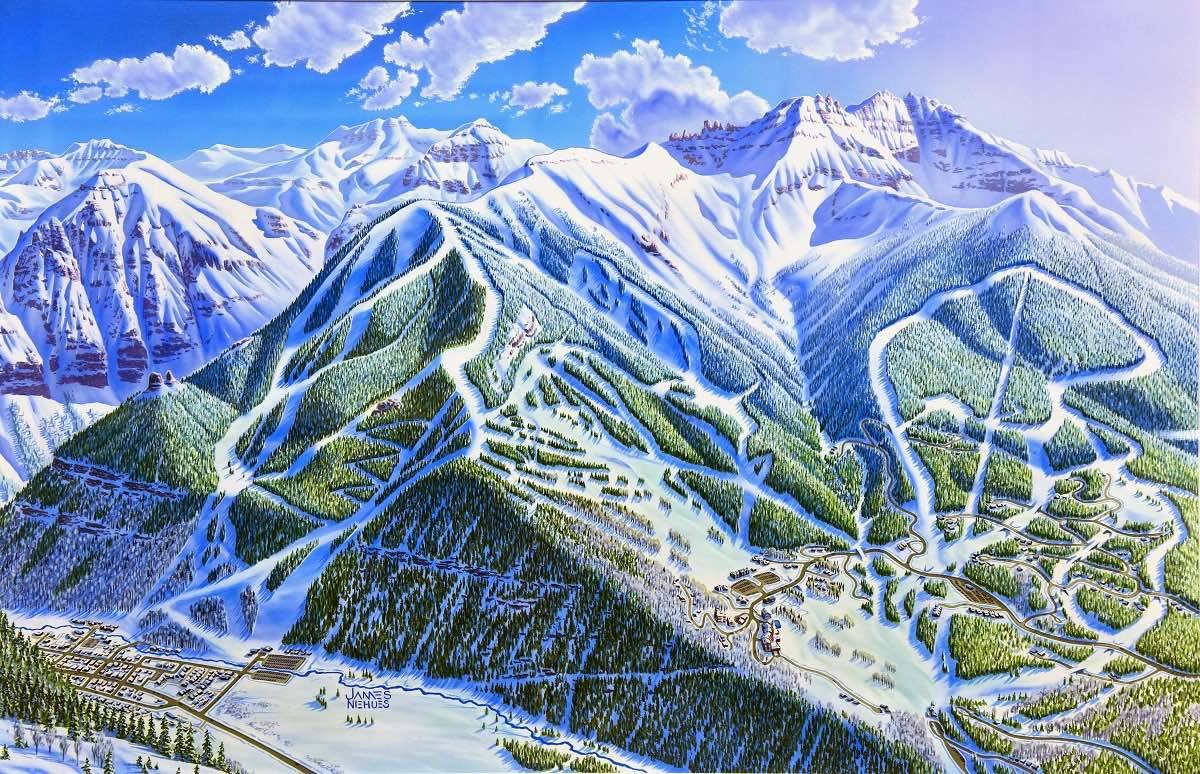
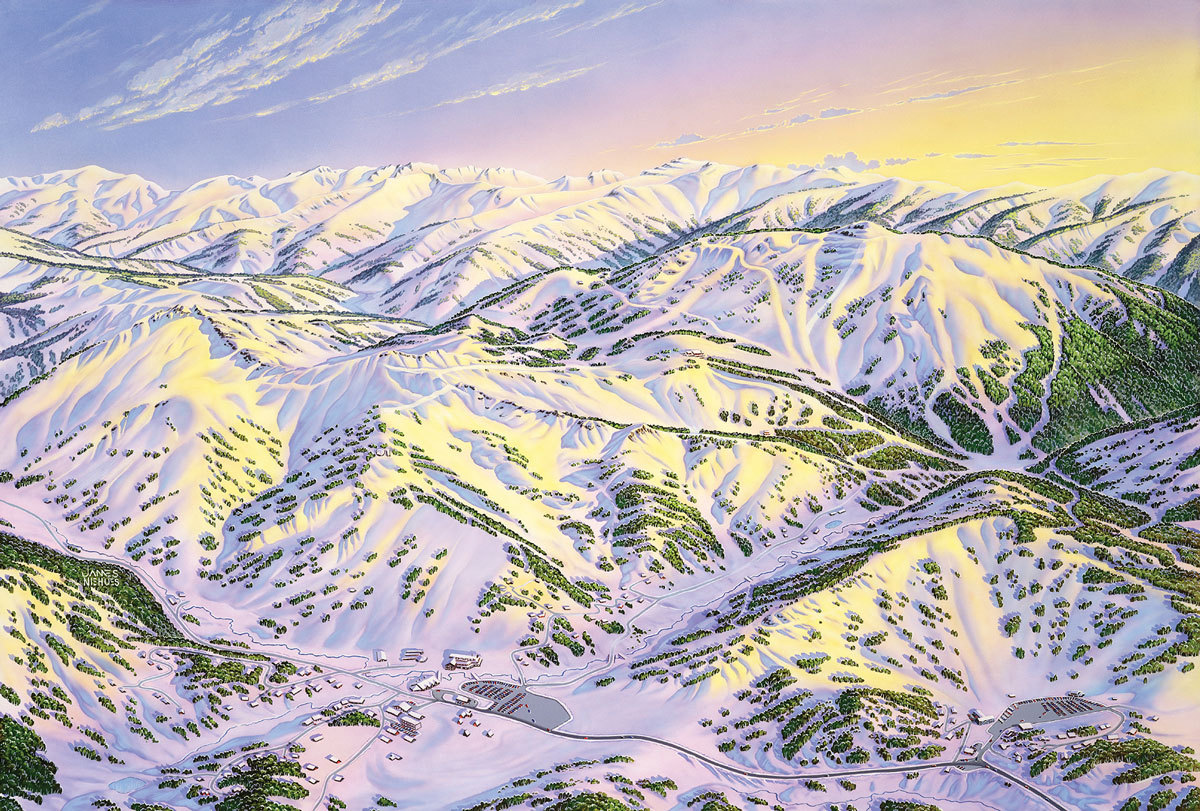
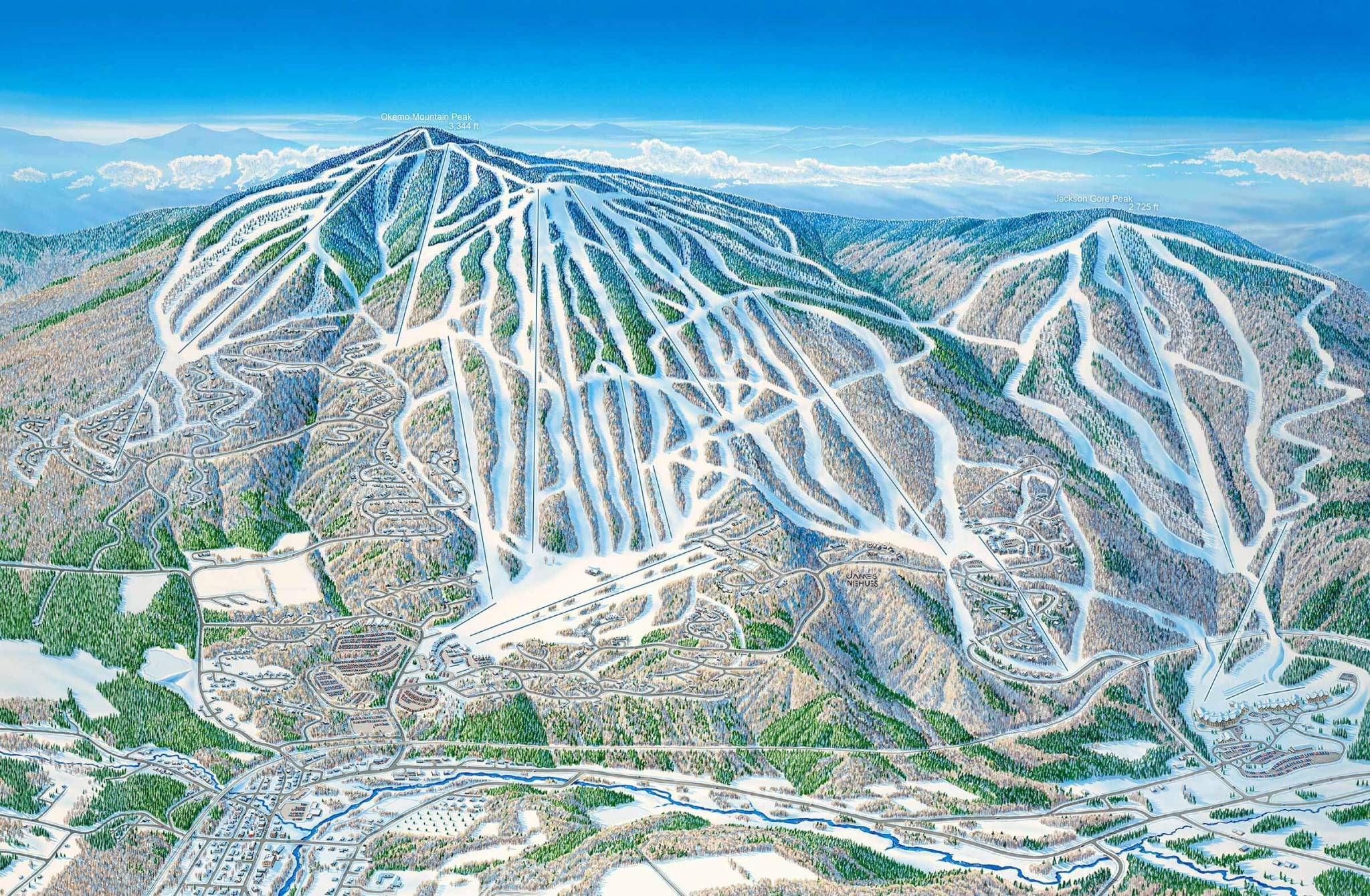
James Niehues’s famous ski resort maps.
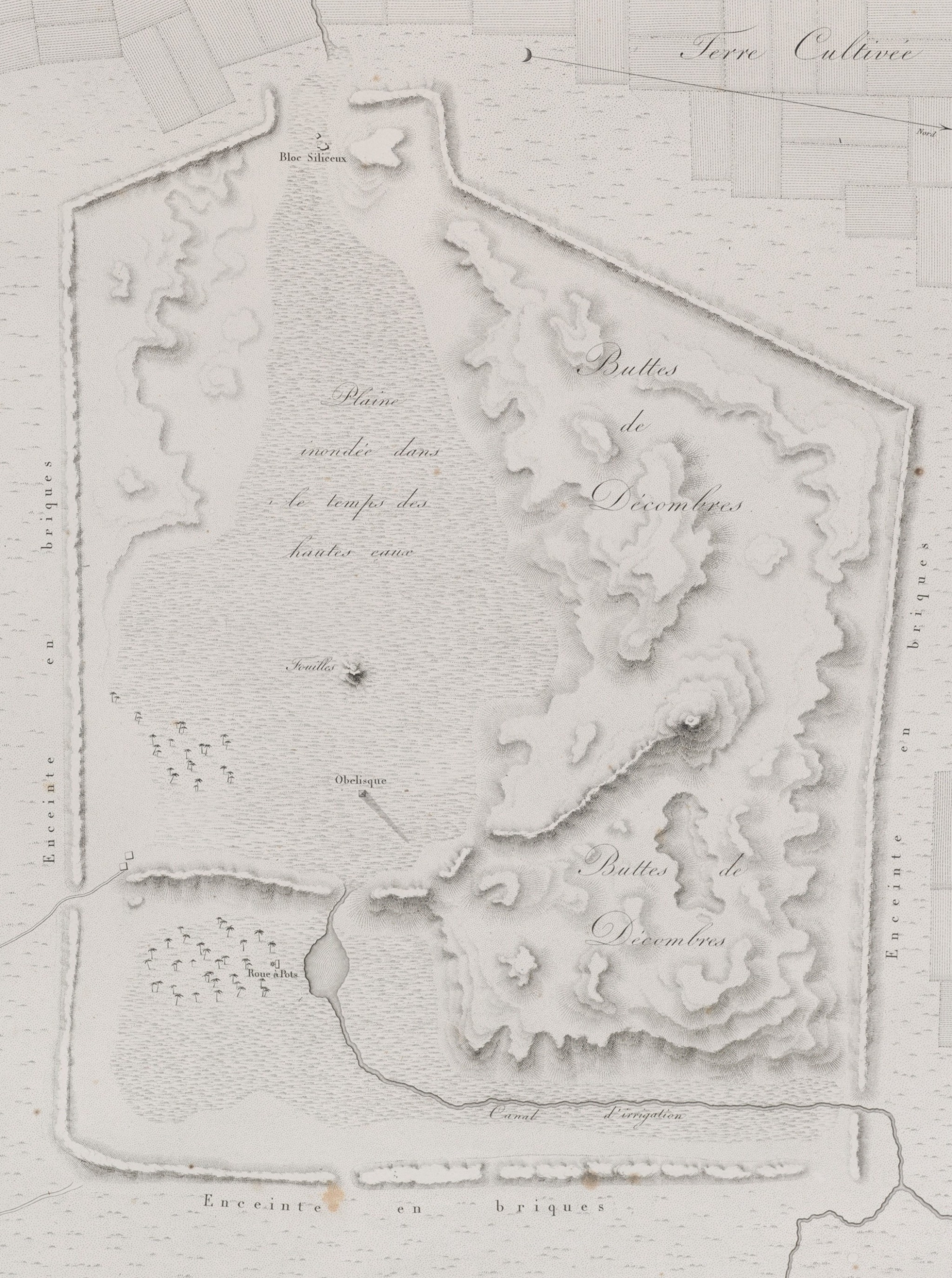
Heliopolis , from Description de l’Égypte , 1809.
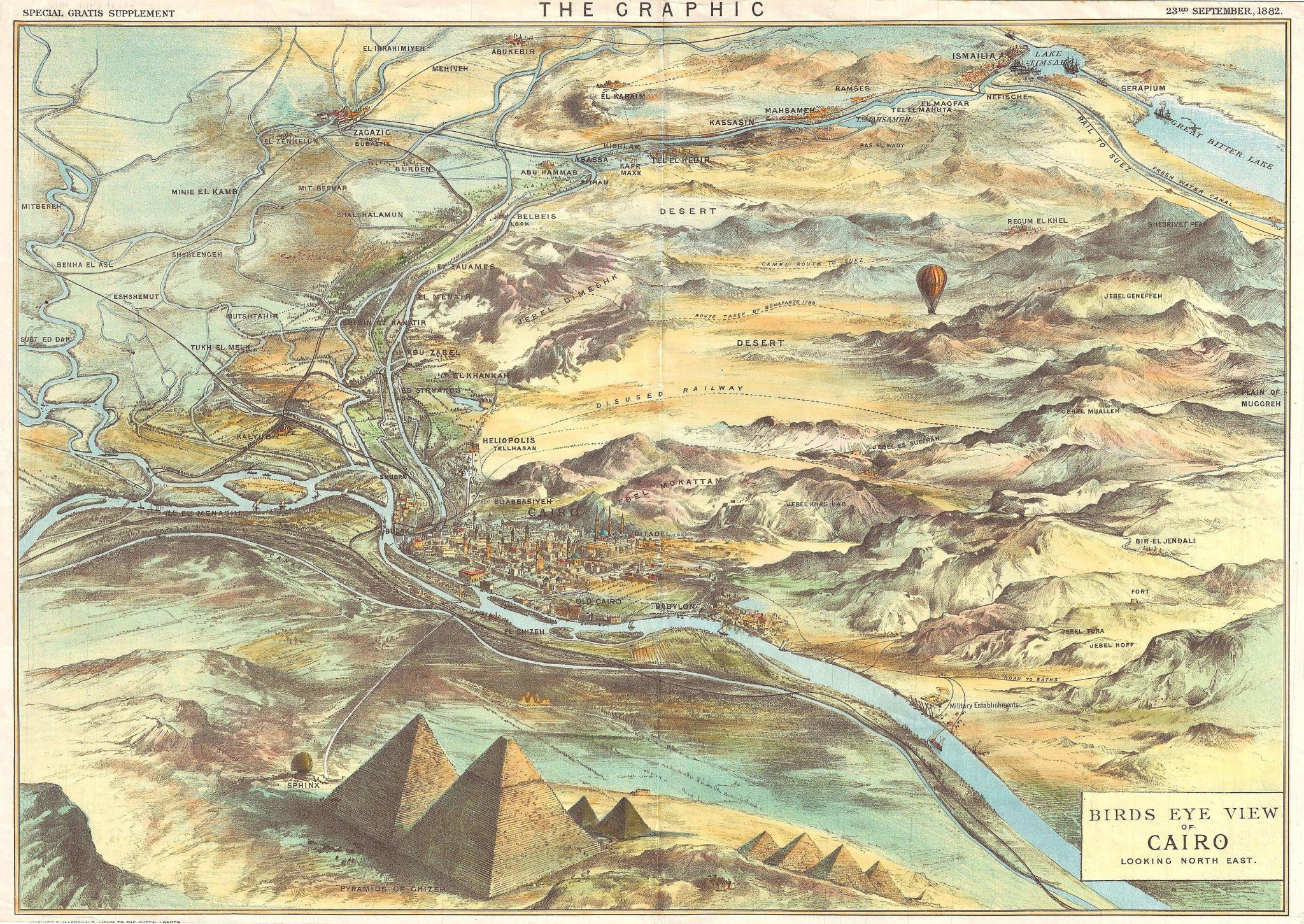
Bird’s eye view of Cairo , 1882.
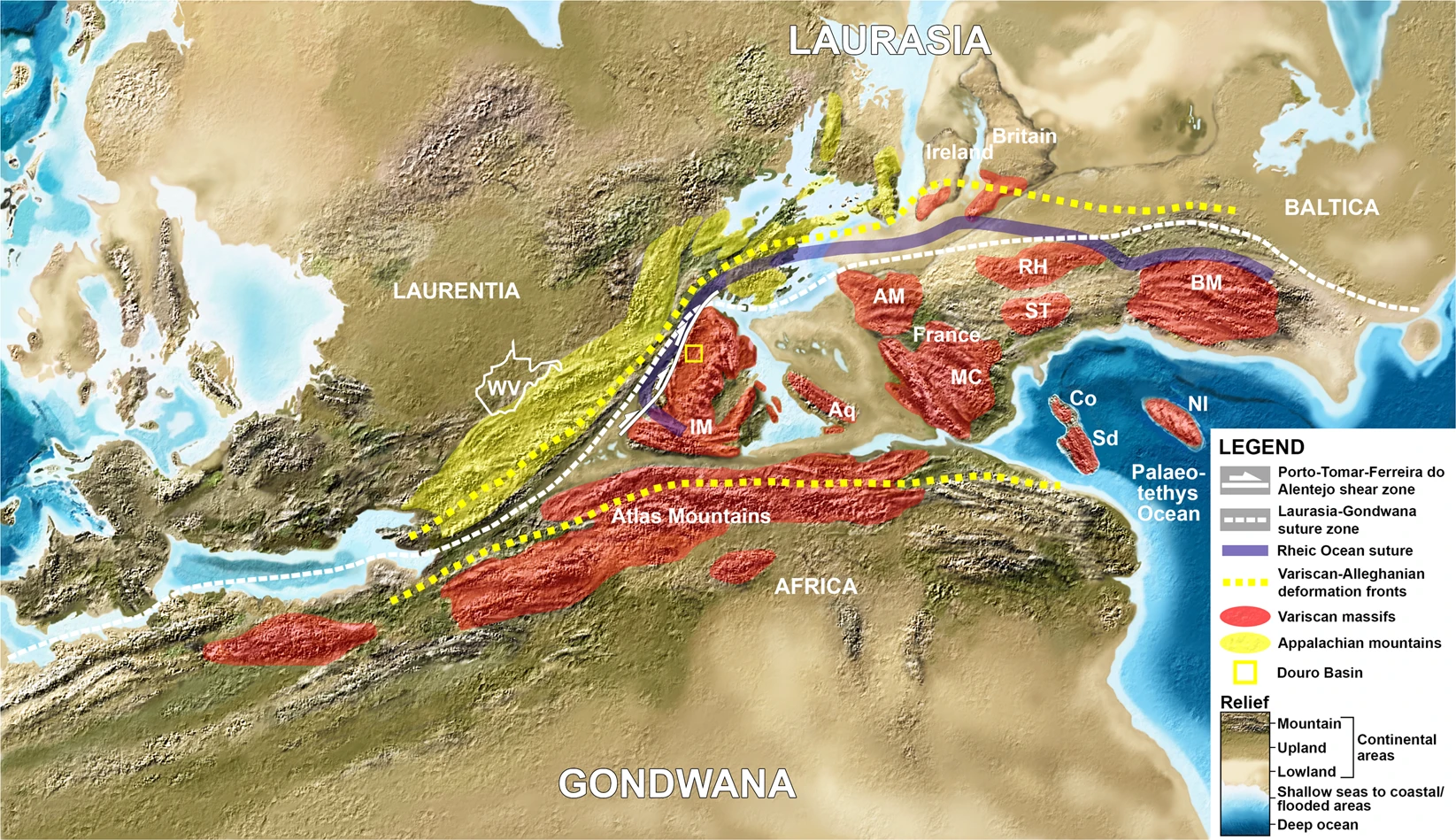
If you go back to the Permian, you’d find the Appalachians, Massif Central, Atlas Mountains, and Scottish Highlands were all part of a single range cutting through the Pangean supercontinent.
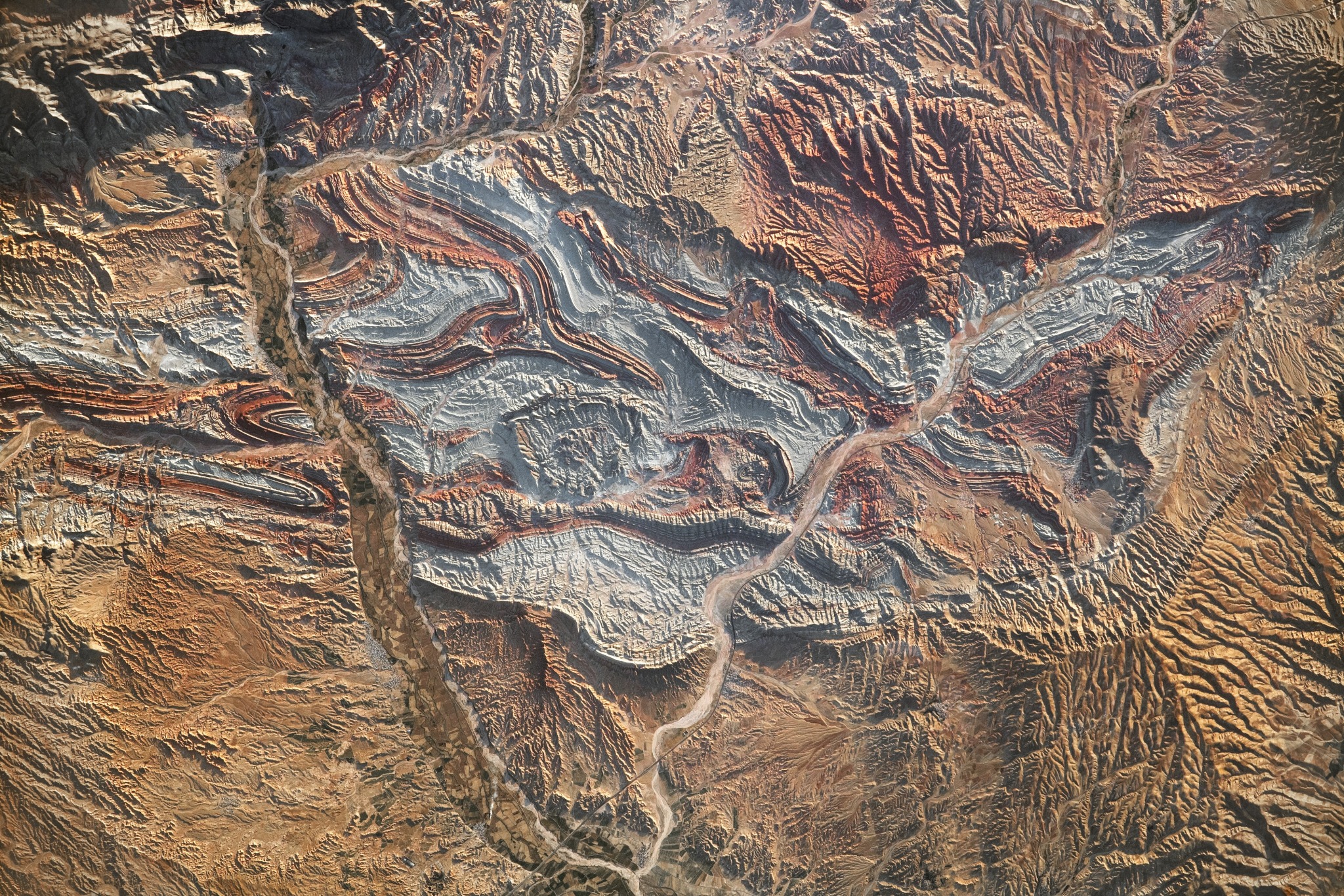
The Aladaghlar Mountains of northwest Iran.
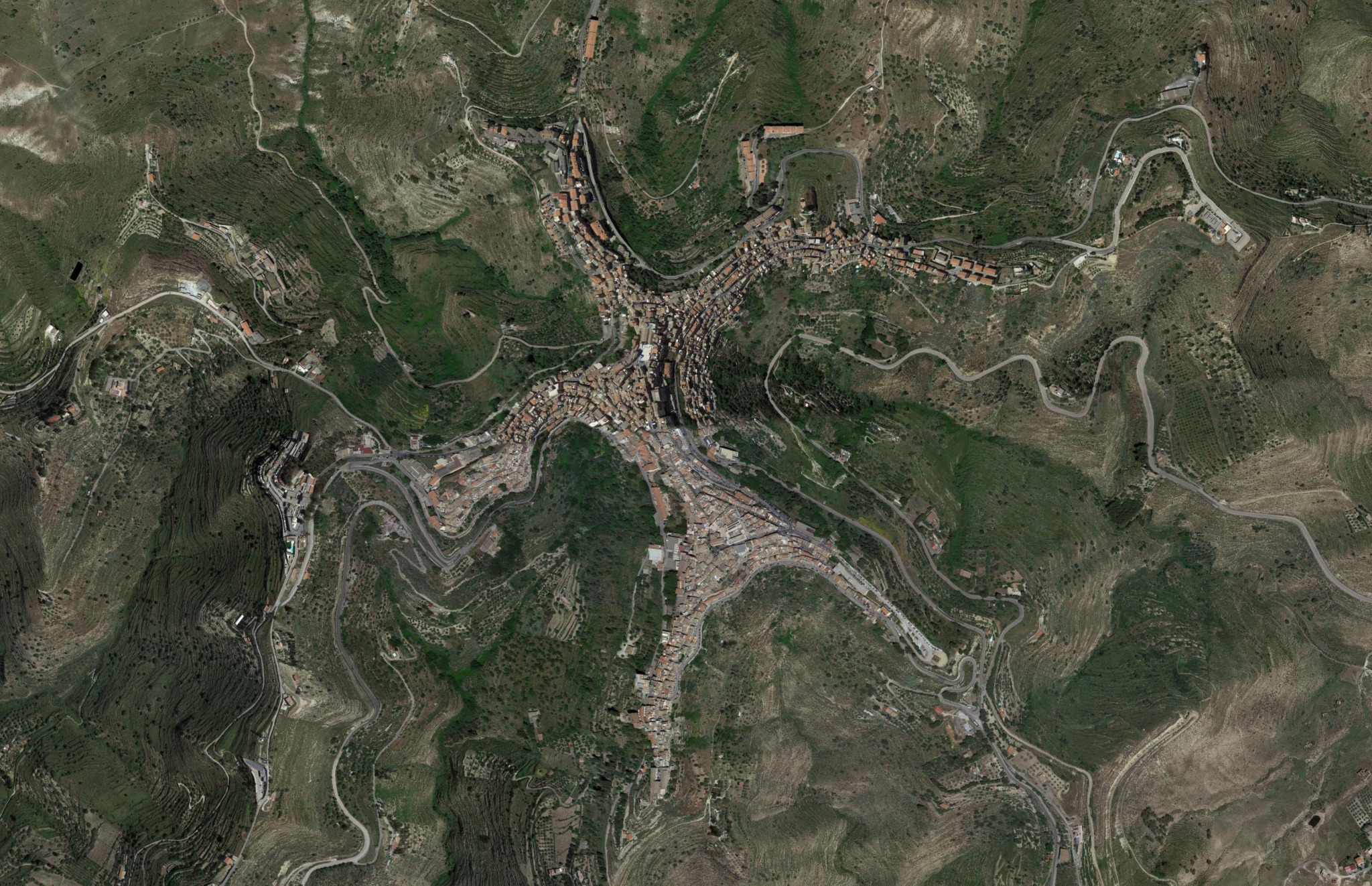
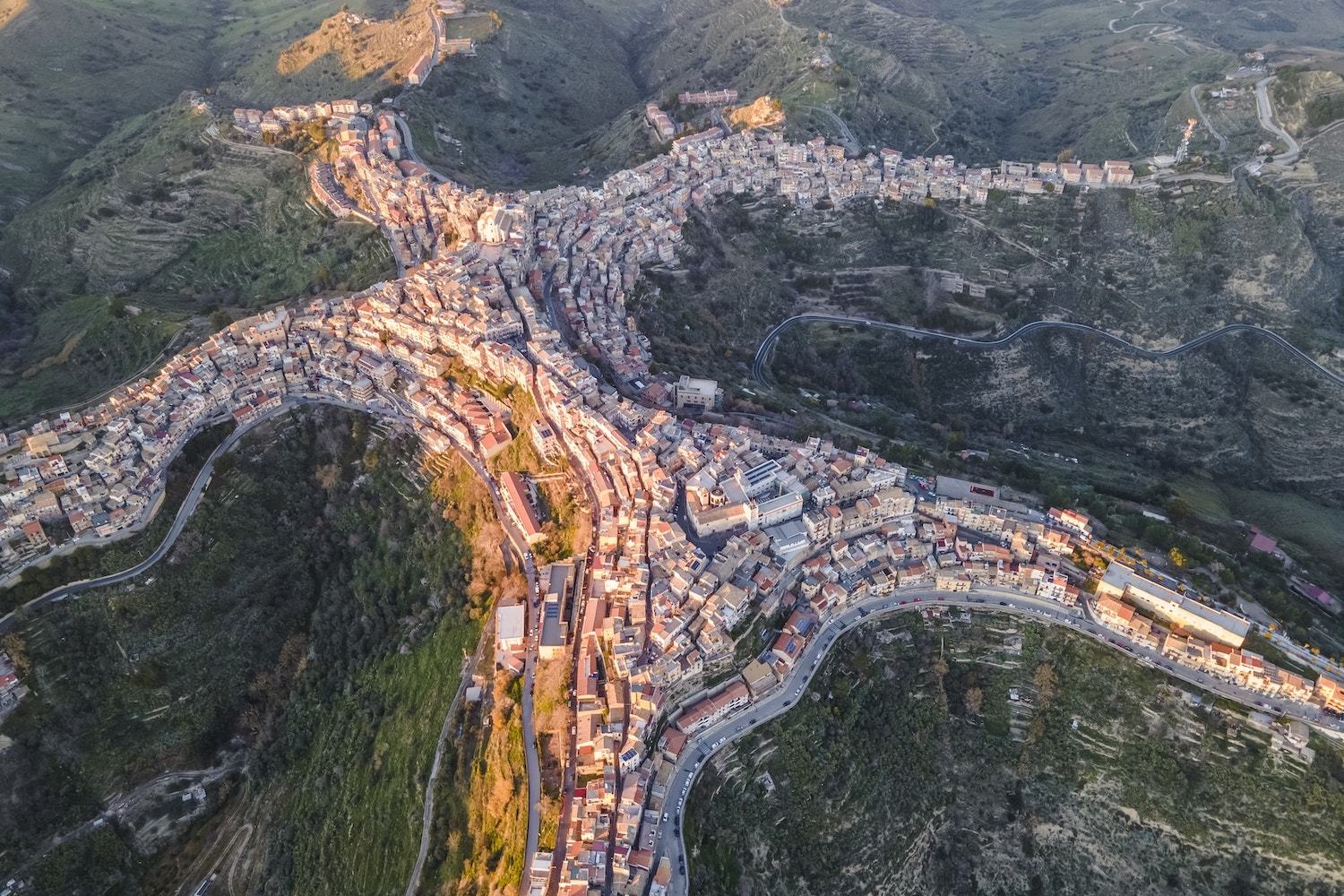
Centuripe — a Sicilian town that looks like a person.
Browsing maps is my favorite way into new rabbit holes. Now central Sicily is on the travel wishlist.
Neat tool for the curious when traveling.
Google has released a massive dataset of building footprints, extracted from high resolution satellite imagery:
The dataset contains 1.8 billion building detections, across an inference area of 58M km2 within Africa, South Asia, South-East Asia, Latin America and the Caribbean.
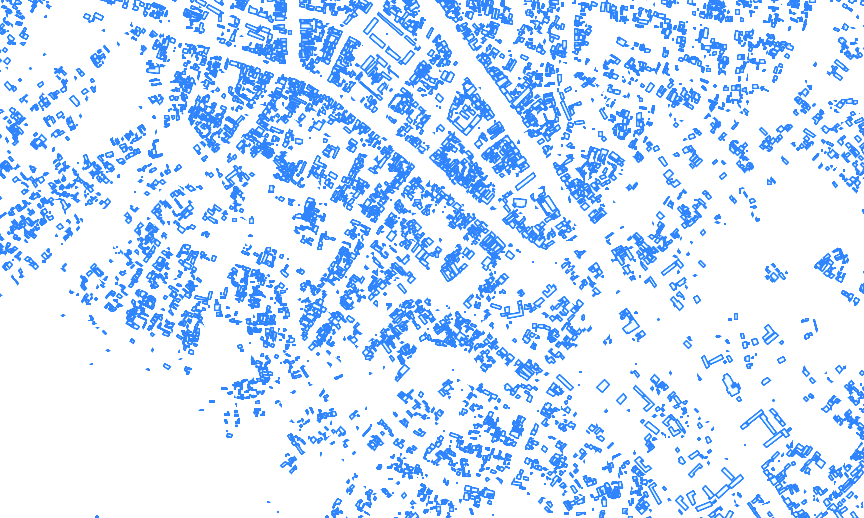
1.8 billion features is enormous, and it doesn’t even cover North America, Western Europe, most of China, Japan, or Australia. Incredible stuff, licensed under CC-BY-4 and ODbL.
The spread of written language around the world, from Egyptian hieroglyphics to today.
Geospatial analytics company Descartes Labs recently sold to private equity, in what former CEO Mark Johnson calls a “fire sale.” This post is his perspective on the nature of the business over time, their missteps along the way in both company identity and fundraising, and some of the shenanigans that can happen as stakeholders start to head for the exits.
Not knowing much about Descartes’ actual business, either the original vision of the product or its actual delivery over the years, I don’t have much specific perspective to offer. But this story is a recurring theme in the world of spatial, earth observation, and analytics startups that have come and gone over the past 10 years or so. These businesses are built on extremely capital-intensive investments in satellites, space-based sensors, and data, which are major hurdles that cause many of them to get sideways in their fundraising structures very early in their business journeys.
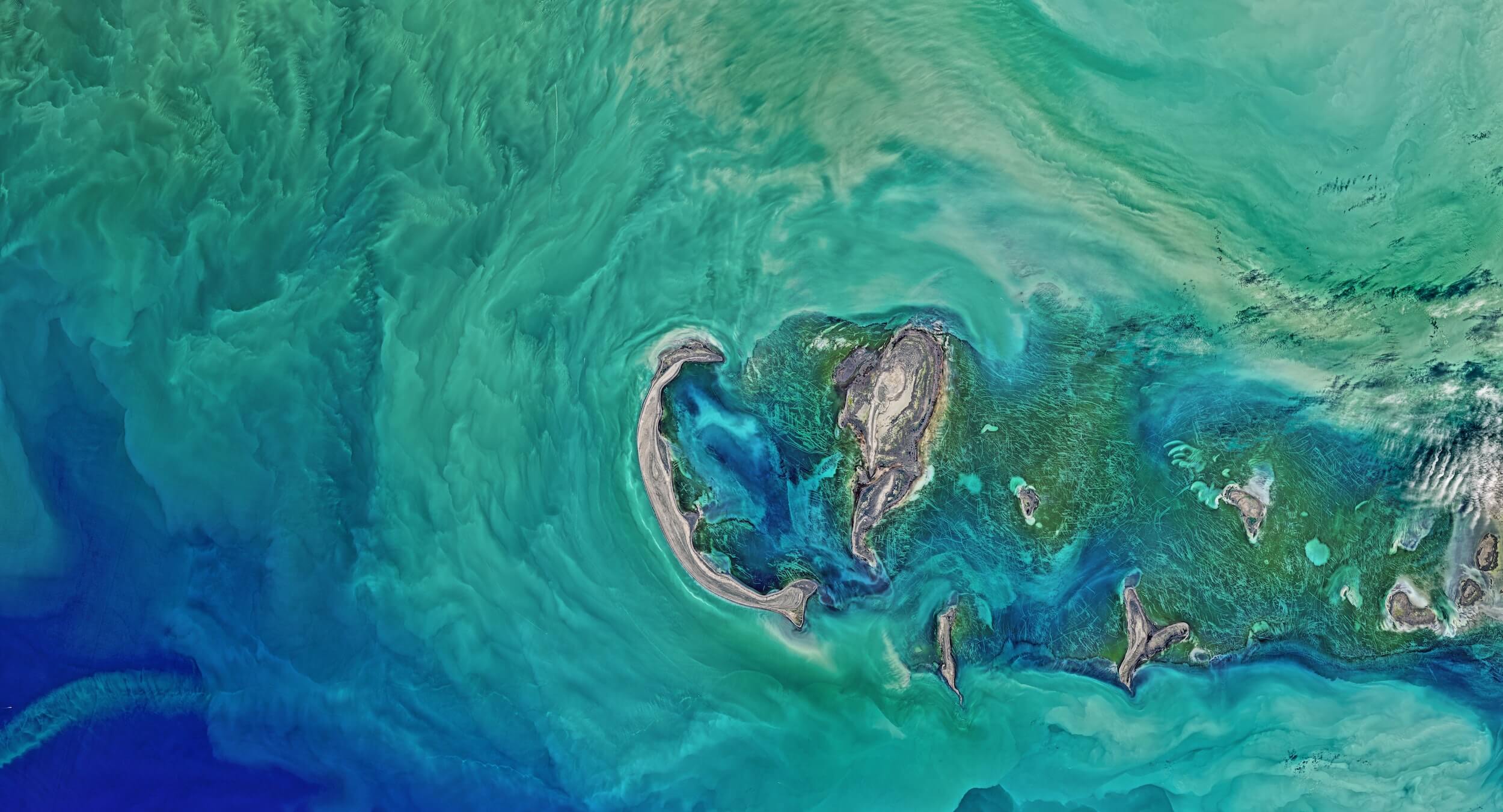
The early years of a startup are always extremely volatile, with pivots and adjustments happening along the way as the company navigates the idea maze, looking for product-market fit. I think the heavy capital required up front compels funders to expect too much too soon in the product development process. There’s a chicken-and-egg problem — the PMF search in these kinds of businesses costs many millions. If you’re building a SaaS project management tool, you can wander around looking for fit for years with only a few people and limited seed money. But in satellite startups, the runway you need to do product-market experimentation is enormously expensive. Large enough funding pools also saddle the business with aggressive expectations for customer counts, growth, and revenue. With revenue targets set but no repeatable PMF, many of these startups do whatever they can to find dollars, which often leads to doing what are effectively custom services deals for a single or few customers. That’s necessary to make money of course, and it’s not valueless for product validation. But it’s too narrow to function as true PMF. Stay in this awkward state too long and you end up stuck down the wrong hallways of the idea maze. You’ll never find the fitness you need to build a lasting business. Bill wrote a great post on this recently, about this identity struggle between being a solutions, services, or product company.
The best thinking on the topic of EO and satellite data companies is my friend Joe Morrison’s newsletter, “A Closer Look”. He leads product for Umbra, a startup specializing in SAR. He’s done a lot more thinking than me on this topic and has thoughtful takes on the satellite and geo market in general.
One of the neatest data visualization projects I’ve seen lately is Topi Tjukanov’s “Map of Notable People.” It takes a database of birthplaces of notable people and maps them to cities on a global interactive map. Surprisingly addictive to pan around.

From the world of geophysics, a massive-scale seismic research project has been happening surrounding the island of Réunion, a shield volcanic dome over an Indian Ocean hotspot. Researchers have been using a stream of data collected from a web of seismometers in the region to map out the superheated plumes of mantle material that bubble up from the core.
In 2012, a team of geophysicists and seismologists set out to map the plume, deploying a giant network of seismometers across the vast depths of the Indian Ocean seafloor. Nearly a decade later, the team has revealed that the mantle is stranger than expected. The team reported in June in Nature Geoscience that the plume isn’t a simple column. Instead, a titanic mantle plume “tree” rises from the fringes of the planet’s molten heart, with superheated branchlike structures appearing to grow diagonally out of it. As these branches approach the crust, they seem to sprout smaller, vertically rising branches — super hot plumes that underlie known volcanic hot spots at the surface.
The data has resulted in higher-resolution 3D modeling of these plumes than we’ve seen before, showing how fractal, tree-like structures happen even in geophysical processes embedded in the earth. These patterns are everywhere in nature, even in slow-moving rock. The article comes with some cool graphics showing what these structures look like, stretching from the core up to the surface forming continent-sized columns.
Geologic timescales are impossible to comprehend in their scale. So I love it when writers accelerate the events for effect:
Some scientists suspect that plumes from the African giant blob spent at least 120 million years tearing the ancient supercontinent of Gondwana into shards. As the plumes rose into its base, they heated it and weakened it; like moles making hills, they caused the land atop these plumes to dome upward, then slide downhill. Australia was unzipped from India and Antarctica, Madagascar from Africa, and the Seychelles microcontinent from India — an act of destruction that made the Indian Ocean.
The resemblance between Martian and Terran topography is amazing. Mars has volcanism, plains, valleys, and hard evidence of water formerly everywhere.
Great shots here with renderings of Martian topography.
Julian Lehr is onto something here. All modern organizations are plagued with a problem of managing internal documentations. We have ample tools and keep squishing the problem from one place to another: wikis, search, tasks — it’s a game of whack-a-mole to find the right version of a document. He ponders at what size it makes sense to invest in a “digital librarian”:
A friend at Stripe recently suggested – half-jokingly – that we should hire a librarian to organize all our internal data and documentation. The more I think about it, the more I like the idea. Perhaps every company should hire a Chief Notion Officer once it hits 100 employees??
Up created a tech tree representation of their product and roadmap. Genius.
Speculative maps of alternate historical timelines.
My friend Joe Morrison wrote an excellent piece on the current state of corporate investment in OpenStreetMap:
The four companies in the inner circle — Facebook, Apple, Amazon, and Microsoft — have a combined market capitalization of over six trillion dollars.¹ In almost every other setting, they are mortal enemies fighting expensive digital wars of attrition. Yet they now find themselves eagerly investing in and collaborating on OSM at an unprecedented scale (more on the scale later).
The post references Jennings Anderson’s analysis of corporate contributions to the project (check out the paper), which has skyrocketed in the past couple of years. Mapbox was an early major contributor, but not the first. But what blew my mind from Jennings’s talk from State of the Map was the scale that teams at Apple and Amazon have achieved in not just use of OSM, but also contributions back to the data. Just look at the number of users on Apple’s data team.
I haven’t kept up with the latest happenings in OSM over the last couple years, but corporate involvement (or any kind of official involvement taking the project beyond hobbyists) is ultimately healthy for the growth of the project. It seems like the scale and quality has expanded over the last 5 years to “irreplicable” levels for everyone except the larget players (ahem, Google).
My prediction is that automated extraction is going to overtake a still-unknown but major chunk of imagery-to-map tracing style mapping. There are still lots of corrections and details that are hard to detect by imagery, but projects like RAPiD are super interesting.
A review of some of the most important mapmaking achievements in history, from the ancient to the modern.

This image from Landsat 8 shows the western end of the English Channel off the coast of Cornwall. A phytoplankton bloom spreads for dozens of miles, filling the St. Austell Bay.
The only time I was on the Channel was on the ferry from Dover to Calais, on a particularly rough but clear day.
English Channel :: 50°01' N, 4°31' W
I didn’t realize until reading this piece that this movie was a commercial flop. $70m gross on a $76m budget. I remember seeing this several times in theaters, and many times after. This retrospective (from 2016) brought the film back to mind and makes me want to rewatch.
Brian Timoney:
Google Earth led us to vastly overestimate the average user’s willingness to figure out our map interfaces. The user experience was so novel and absorbing that people invested time into learning the interface: semi-complex navigation, toggling layers on and off, managing their own content, etc. Unfortunately, our stuff isn’t so novel and absorbing and we’ve learned the hard way that even those forced to use our interfaces for work seem very uninterested in even the most basic interactions.
It’s great to see Brian blogging again!
What’s happening between the New York Times and psychiatrist-rationalist-blogger Scott Alexander is incredibly disappointing to see. In writing a story including him, they want to use his real name (which they found out somehow, S.A. is a pseudonym), which seems completely unnecessary and absurd to the point of disbelief — given the Times’ behavior and policies of late, there should be little benefit of the doubt given here. As a result of this, Scott has deleted his blog, one of the treasures of the internet.
A 2017 commencement address from Mihir Desai, critiquing the phenomenon of infinite optionality and lack of commitment pushed by modern universities:
I’ve lost count of the number of students who, when describing their career goals, talk about their desire to “maximize optionality.” They’re referring to financial instruments known as options that confer the right to do something rather than an obligation to do something. For this reason, options have a “Heads I win, tails I don’t lose” character—what those in finance lovingly describe as a “nonlinear payoff structure.” When you hold an option and the world moves with you, you enjoy the benefits; when the world moves against you, you are shielded from the bad outcome since you are not obligated to do anything. Optionality is the state of enjoying possibilities without being on the hook to do anything.
Nice paleocartography here. India abuts Antarctica, South Africa up against Argentina, and Iran was a peninsula.
Bryan wrote this post about how Fulcrum is supporting the COVID response efforts.
I speculated a bit about this sort of thing earlier this week. How might urban design change?
One of the most pressing questions that urban planners will face is the apparent tension between densification – the push towards cities becoming more concentrated, which is seen as essential to improving environmental sustainability – and disaggregation, the separating out of populations, which is one of the key tools currently being used to hold back infection transmission.
Some colleagues in the geo community are working on this project to map health care resources by region and facility. All of the code and work is in the open on GitHub.
A technical piece describing the goals for Facebook’s rewrite of the Messenger app. Interesting to see them avoiding their own React Native for this, and doing things in native iOS/Android.
A humorous post, but has a point. There’s pressure to add new tools that don’t do much but add moving parts and complexity. There’s nothing wrong with Kubernetes, but there’s a place for it (and your small team probably doesn’t need it).
The more you buy in to Kubernetes, the harder it is to do normal development: you need all the different concepts (Pod, Deployment, Service, etc.) to run your code. So you need to spin up a complete K8s system just to test anything, via a VM or nested Docker containers.
And since your application is much harder to run locally, development is harder, leading to a variety of solutions, from staging environments, to proxying a local process into the cluster (I wrote a tool for this a few years ago), to proxying a remote process onto your local machine…
Mapbox digs into the impacts of San Francisco’s Market Street going pedestrians and bikes only.
An entertaining talk about the complexity of typography, from Marcin Wichary at Figma’s recent Config conference.
An technical piece on restoring Alan Kay’s Xerox Alto he donated to Y Combinator. Amazing piece of technology history, and inspired so many future developments in computing — graphical user interfaces, WYSIWIG text editing, bitmapped graphics, the mouse, and Ethernet for connectivity.
Xerox built about 2000 Altos for use in Xerox, universities and research labs, but the Alto was never sold as a product. Xerox used the ideas from the Alto in the Xerox Star, which was expensive and only moderately successful. The biggest impact of the Alto was in 1979 when Steve Jobs famously toured Xerox and saw the Alto and other machines. When Jobs saw the advanced graphics of the Alto, he was inspired to base the user interfaces of the Lisa and Macintosh systems on Xerox’s ideas, making the GUI available to the mass market.
A timeline showing the spread of the coronavirus, with an accompanying map interface.
Google Maps just had its 15th birthday. This post from one of the original team on Maps back in 2005, Elizabeth Reid, reflects on a history of the product from its first iteration.
On Feb 8, 2005, Google Maps was first launched for desktop as a new solution to help people “get from point A to point B.” Today, Google Maps is used by more than 1 billion people all over the world every month.
It was the early days of Web 2.0, and Google’s launch of the Maps API was one of the keys to the “mashup” movement that sparked a new wave of startups.
As a geographer, Google Maps and Earth are tools I use every day, both for fun and work. Maps is likely up there with Wikipedia at the top of my web visit history over the last 15 years.
Hard to believe they launched Street View all the way back in 2007. Today it still surprises me how much data that’s been collected, and the amazing feeling of zooming into any place to see it from the ground level.
Mike Bostock published this cool Observable notebook that generates snapshots showing road networks of centrally-planned cities. Brasilia as an example:
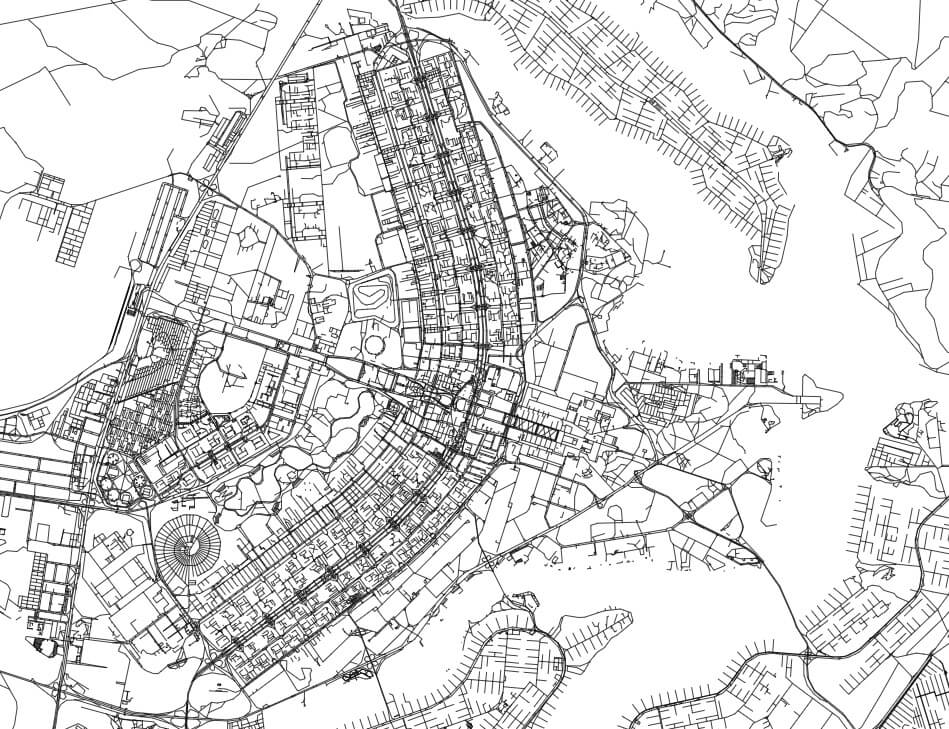
It uses a combo of D3 and OpenStreetMap data to generate vector tiles.
I finally got around to updating my local tracks database with all of the 2019 Strava data. I’ve been lax about updating it since I completed the Shore Acres project in the summer. Here are some fun snapshots:

This one shows how much of the St. Pete area I covered. Almost finished Snell Isle, as well, but missed a few segments. I might polish that off this year then work on the downtown area.

This was my first half marathon, and only time running out on Fort DeSoto. Great spot for this. Might try to do some of it for fun during the winter while it’s cooler. It was about 78°F at 7am when the race started that day.
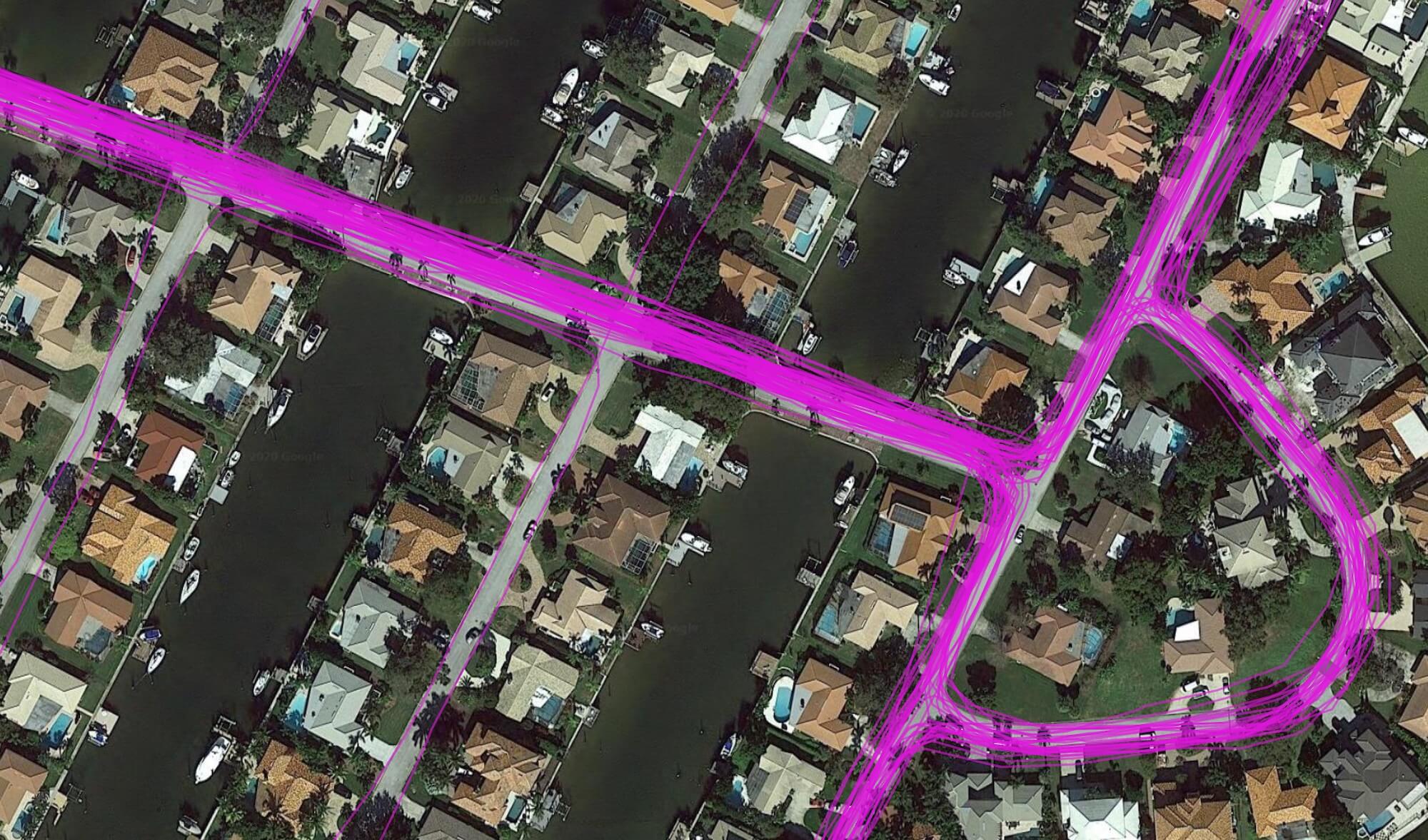
This is what my common running routes look like. This spot out at the end of Venetian Isles near my neighborhood is one of my normal routes. Looks wild to see how many times I’ve been on that sidewalk.
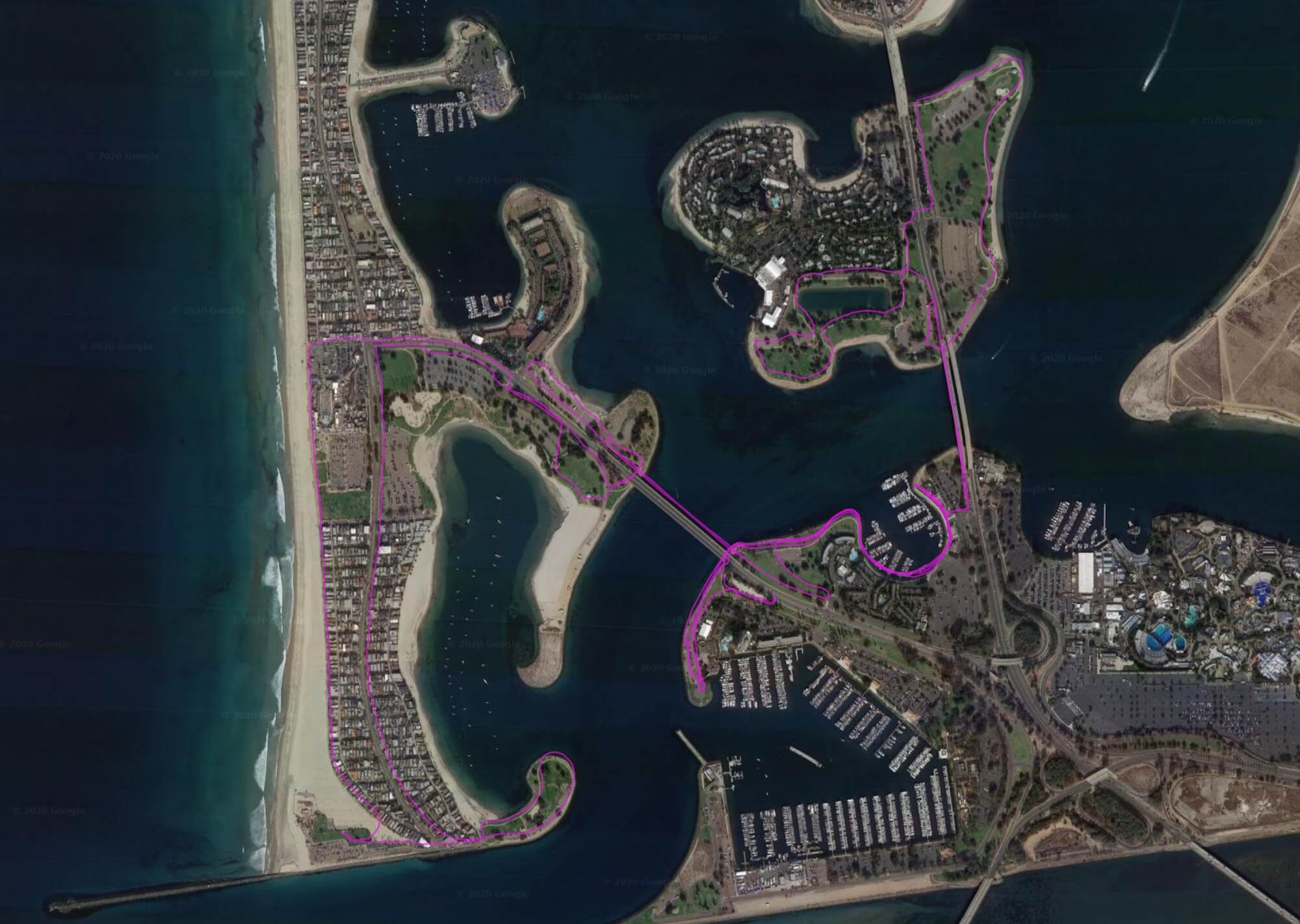
When I was out at FOSS4G in San Diego in the spring I got in a couple of long runs. The Mission Bay area is beautiful.
Just getting started on 2020, about 32 miles in so far. I’m a little behind schedule on my pace for 650 miles, but should be able to catch up and keep it going.
Combining baseball and maps? Sign me up. The MLB has a plan to “improve” the MiLB system costs, standards, compensation, and other things through shuttering 42 ball clubs around the country. In this piece for FanGraphs, the authors use some GIS tactics to analyze how this shakes out for baseball fans falling within those markets:
So how many Americans would see their ability to watch affiliated baseball in person disappear under MLB’s proposal? And how many would see their primary point of access shift from the relatively affordable games of the minor leagues to major league ones? To work out how the closure of these minor league teams will affect access to baseball, we went to the map. More specifically, we took the geographical center of each ZCTA (a close relative of ZIP Codes used by the Census Bureau). We calculated the distance as the crow flies from each ZCTA to each ballpark in America, both in 2019 and in MLB’s proposed new landscape.
Seems like a strange move for transit agencies to sell the naming rights to entire stations to private entities. Would it really raise revenues enough to make a dent in paying for operations or improving systems? Seems like the downsides outweigh the upsides here. I’m all for experimentation in improving public services, but this seems like a lazy method for raising a few million bucks.
I did learn a new handy phrase here:
There’s a phrase that urban geographers use for this private rebranding of public space: “toponymic commodification.”
Another one for the sports fan, an analysis and comparison of different players.
Turns out cultures from warmer climates evolved a taste for spicy foods to combat the presence of more diverse bacteria:
Alas, nothing in nature turns out to be that simple. Researchers now suggest that a taste for spices served a vital evolutionary purpose: keeping our ancestors alive. Spices, it turns out, can kill poisonous bacteria and fungi that may contaminate our food. In other words, developing a taste for these spices could be good for our health. And since food spoils more quickly in hotter weather, it’s only natural that warmer climates have more bacteria-killing spices.
The German scientist Alexander von Humboldt is one of the most important figures in conservation and geography. He was one of the first scientists to use maps as a critical tool for communicating his discoveries and ideas:
Another of Humboldt’s groundbreaking illustrations came out of his five-year voyage to Central and South America with the French botanist Aimé Bonpland. In 1802, Humboldt and Bonpland ascended Chimborazo, a volcano just below the equator that was believed at the time to be the highest mountain in the world (at 20,564 feet, it’s more than 8,000 feet shorter than Mount Everest). The pair documented the mountain’s plant life, from the tropical rainforest at its base to the lichen clinging to rocks above the treeline. The image below, which Humboldt called Tableau Physique in the French version of his original publication, organizes these observations in an intuitively visual way, showing Chimborazo in cross-section, with text indicating which species lived at different elevations on the mountain.
There was a roil over a Bill Gates interview from the recent DealBook conference, specifically around his comments on the upcoming election and his uncertainties around the Democratic candidates’ tax policies and consequences they might have. As is usual for Twitter, the rage machine was in full effect around Gates’s comments about “how much he’d have left” if Elizabeth Warren had her way.
The notion commonly tossed around with regard to billionaires is that there’s no way that level of wealth accumulation could happen through non-nefarious (or illegal) means. Kevin Williamson does a good job in this piece picking apart the logic here (or lack thereof) around “wealth transfer” — a disingenuous way to describe a phenomenon where there was no coercion involved.
The idea that there is some big national slop bucket marked “income” and that Gates et al. are grabbing up more than their fair share is breathtakingly primitive. A relatively small number of high-growth firms has accounted for a very large share of economic growth in the United States in the past several decades. That represents wealth creation, not a wealth transfer.
Blot is a super-minimal open source blogging system based on plain text files in a folder. It supports markdown, Word docs, images, and HTML — just drag the files into the folder and it generates web pages. I love simple tools like this.
An interesting post from Robert Simmon from Planet. These examples of visualizations and graphics of physical phenomena (maps, cloud diagrams, drawings of insects, planetary motion charts) were all hand-drawn, in an era where specialized photography and sensing weren’t always options.
A common thread between each of these visualizations is the sheer amount of work that went into each of them. The painstaking effort of transforming a dataset into a graphic by hand grants a perspective on the data that may be hindered by a computer intermediary. It’s not a guarantee of accurate interpretation (see Chapplesmith’s flawed conclusions), but it forces an intimate examination of the evidence. Something that’s worth remembering in this age of machine learning and button-press visualization.
I especially love that Apollo mission “lunar trajectory” map.
Descartes Labs built a wildfire detection algorithm and tool that leans on NASA’s GOES weather satellite thermal spectrum data, in order to detect wildfires by temperature:
While the pair of GOES satellites provides us with a dependable source of imagery, we still needed to figure out how to identify and detect fires within the images themselves. We started simple: wildfires are hot. They are also hotter than anything around them, and hotter than at any point in the recent past. Crucially, we also know that wildfires start small and are pretty rare for a given location, so our strategy is to model what the earth looks like in the absence of a wildfire, and compare it to the situation that the pair GOES satellites presents to us. Put another way our wildfire detector is essentially looking for thermal anomalies.
Strasburg tipping his pitches almost ended the Nats’ run:
He remembered the game Strasburg pitched in Arizona on August 3. The Diamondbacks pounded Strasburg for nine runs in less than five innings. The D-Backs knew what was coming. The Nationals broke down the tape and discovered Strasburg was tipping his pitches by the way he reached into his glove to grip the baseball near his waist, just before he raised his hands to the set position.
An annotated version of Mike Migurski’s workshop on RapiD and Disaster Maps from the NetHope Summit. Facebook’s work on this stuff looks primed to change the way everyone is doing OpenStreetMap contribution.
I’ve never used TikTok, but it’s been a fascination tech story to follow its insane growth over the last 8-12 months. With the current geopolitical climate and the fact that it’s owned by Chinese owner ByteDance, it seemed like this CFIUS investigation was inevitable.
This is a great narrative story from the Wall Street Journal about the current situation in California with PG&E, the rolling blackouts, and the wildfires ravaging the state. Drone video, maps, data on fire risk and infrastructure paint a pretty grim picture of the problem. It’ll take years for PG&E to catch up to where there’s anything resembling a long-term solution to this problem.

In preparation for this year’s Geography 2050 theme (“borders in a borderless world”), this map gives a helpful sense of how relatively young most of the world’s international boundaries are. Outside of Europe, most boundaries are shades of red or blue (dating from 1800 or later).
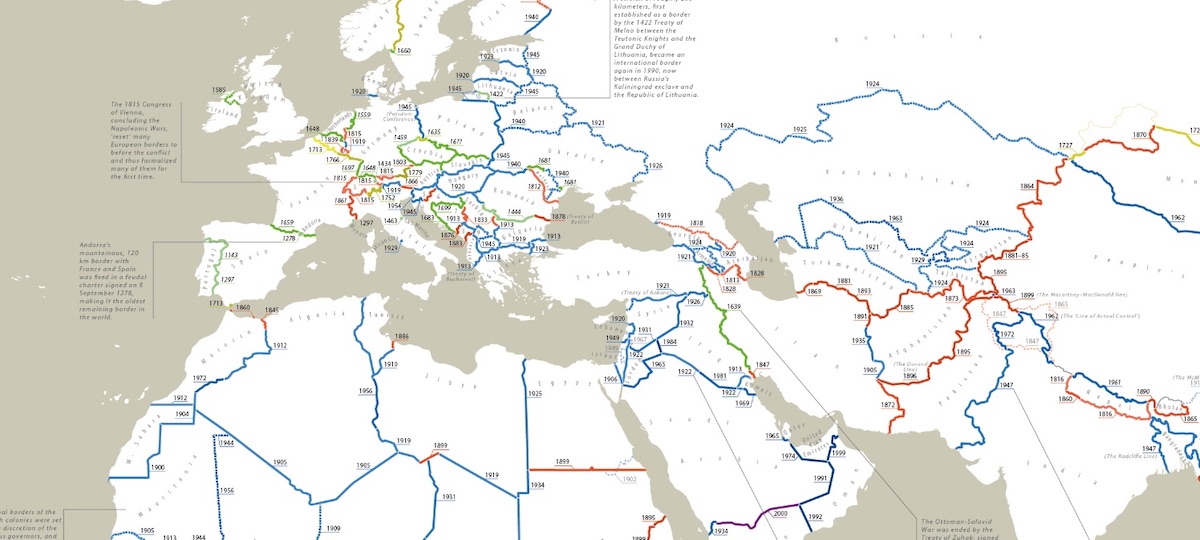
Check out the full size version here.
In a conversation yesterday I learned about this project called RapiD, led by Facebook to use computer vision technology to detect features for mapping in OpenStreetMap. They’re working on a fork of the iD editor that does assistive feature detection to present an editor with generated geometries to add to the map. I messed around with it in the test areas they’re supporting so far and it’s a clever combination of computer-assisted detection and human-based mapping. This shows some promise to enhance OSM contributor technology and lower the barrier to entry for new editors.
I enjoyed this interview with author Ted Chiang. It covers his recent short story collection Exhalation: Stories with nice context and background on the ideas behind each one. I just finished the book last week, and would have to say that The Truth of Fact, the Truth of Feeling was my favorite. A story about the fallibility of memory and what it would be like if our memories were recorded with perfect accuracy.
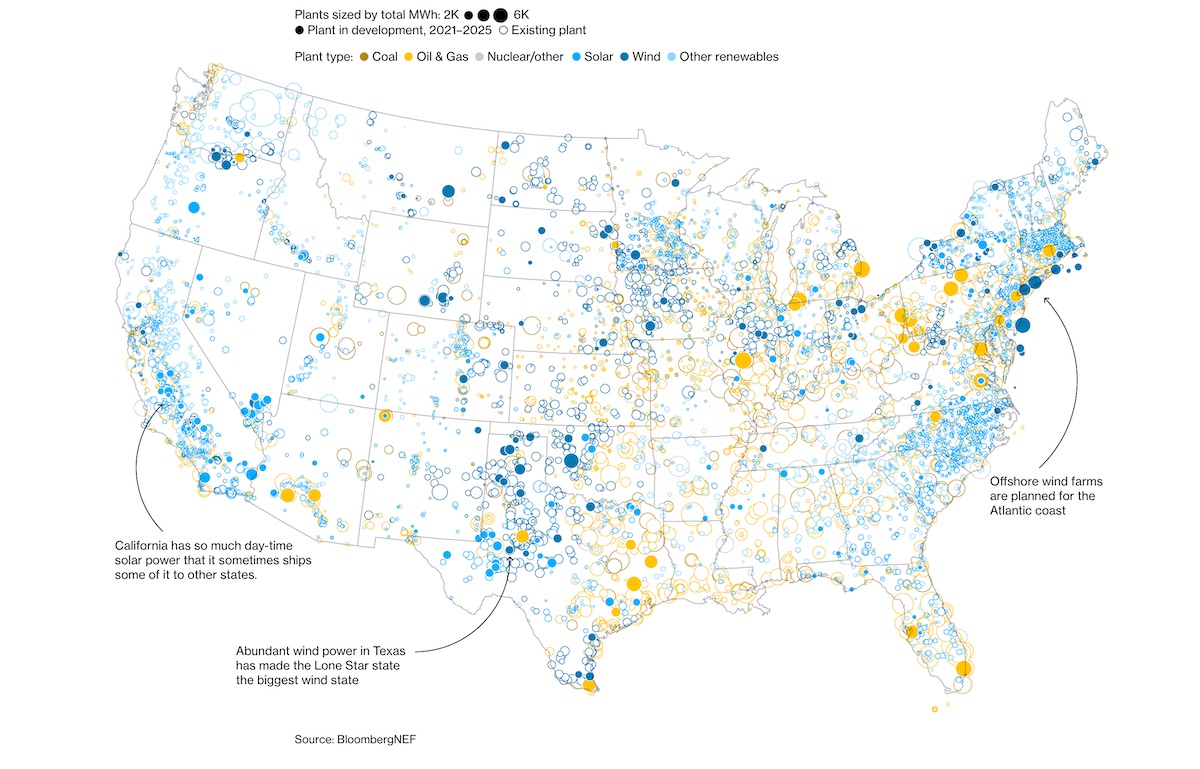
Analysis from Bloomberg on the state of renewables versus fossil fuels, with nice map graphics demonstrating the distribution of energy facilities by type in the US. The trends look positive in the United States, but the outlook in developing markets is still challenging, as one would expect:
In developing parts of the world, coal still dominates. China is home to the largest capacity of hydro, wind and solar power—and it remains the world’s biggest consumer of coal. Pakistan’s dream of generating 60% of its power from clean energy sources is still decades away. In Indonesia, coal plants are so cheap to run that the Southeast Asian nation is projected to nearly double its coal generation in the next 25 years.
The growing divide underscores a global dilemma: Wealthy nations can afford to turn their backs on coal, but it remains an easy fallback in countries where electricity is scarce, unreliable, or unaffordable.
A tool from the Lyft design team for creating color ramps and gradients. Check out the blog post.
This is a cool post on a study done by a research team in the City of Saskatoon, looking at the perceptions of safety in a downtown area. They used Fulcrum to collect survey data using a safety audit developed to capture the on-the-ground intelligence from residents:
Because we were interested in perceptions and fear at a very micro-level, the study area was confined to the blocks and laneways within a four block area. We used our new app to collect information from 108 micro-spatial locations within a radius of 30 meters (100 feet) of each location, and then we also collected 596 additional intercept surveys with members of the public on the street at the time.
The urban design strategy known as Crime Prevention Through Environmental Design (CPTED) is about creating safer neighborhoods through specifically constructing the built environment. From their takeaways in the study:
Interestingly, the respondents’ night-time perceptions did not appear as negative as we expected. Some parts were so inactive at night that we obtained very few interview responses. While CPTED surveys conducted by one team concluded these underactive areas were anxiety-provoking, when late-night social events and festivals activated the area, it positively influenced the perceptions in our surveys with the public.
This week’s links are all interactive notebooks on Observable. Their Explore section always highlights interesting things people are creating. A great learning tool for playing with data and code to see how it works.
Easily the most impressive interactive notebook I’ve ever seen. This one from Tom shows the electromechanical pathways of the German Enigma machine at work — enter a character and see how the rotors and circuits encrypt text.
Another great example of the power of interactive programs. This one lets you compute bicycle chainring gear ratios by speed setting. You can add multiple cassettes and chainrings to compare:
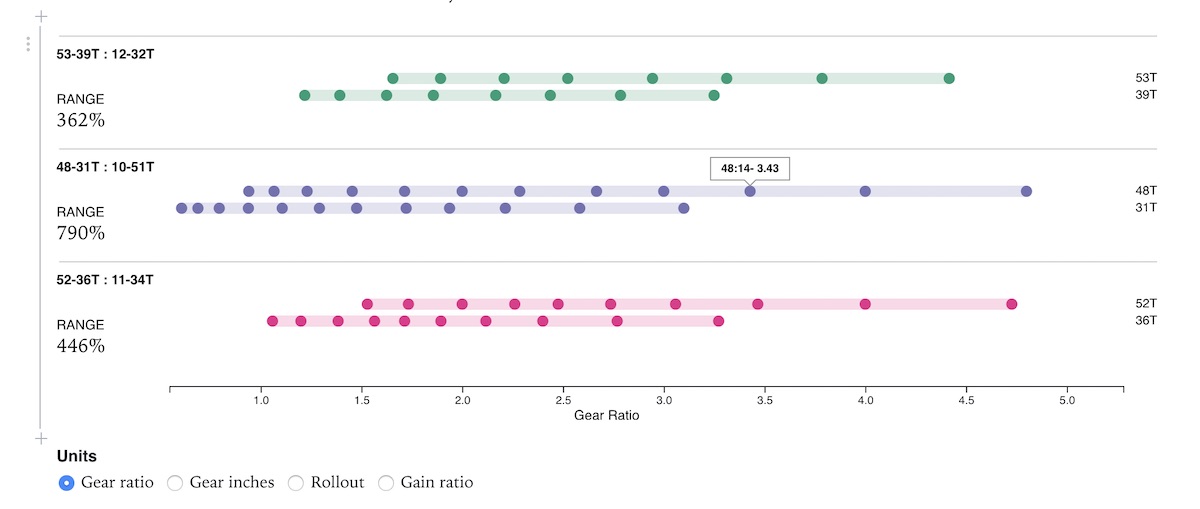
Have to include a map example. Here the author brings in DEM data then styles and generates it all in code with GDAL for data manipulation and D3 for graphics.
This is the kind of stuff that gets you out of bed in the morning and really gets the motivators up to do things like Fulcrum Community to support disaster relief efforts.
When Cyclones Idai and Kenneth steamrolled into East Africa beginning in March, the crew from Team Rubicon was deployed to help with EMT response and recovery in Beira and Matarara, Mozambique. They used Fulcrum to record patient data after prior experience with another partner of ours, NetHope:
Earlier in 2019, Team Rubicon deployed with NetHope to install wireless access points on the Colombia/Venezuela border to provide Venezuelan refugees with access to news information and offers of assistance. NetHope utilized Fulcrum to track access-point install requests as well as record successful installs. Team Rubicon received training on Fulcrum during the deployment and grew to like the offline form entry capability, ability to change forms on the fly, and manipulate and analyze the collected information via the console. When faced with the need to collect medical information in an internet-disconnected environment and transmit reports later when within range of internet, Team Rubicon reached out to Fulcrum for support. Fulcrum provided a community disaster grant to facilitate Team Rubicon’s Cyclone Idai response, including developer assistance to rapidly publish medical forms.
Fulcrum did exactly what we designed it for, providing a robust data platform in an austere, low-comms environment easy for field EMTs to use:
Fulcrum allowed Team Rubicon to quickly enter patient data as well as the multi-sector needs assessment data in a completely disconnected environment. And since the Fulcrum app works on a cellular phone, there was no longer a need to pack bulky and heavy paper forms. Once back at base camp, and with access to internet, Team Rubicon could transmit the daily collected information to its National Operations Center so they could generate the EMT/CC daily reports in the format the EMT/CC preferred.
We’re already looking at other ways we can help the amazing folks from Team Rubicon on future missions with data, reporting, and impact analysis.
Most people don’t know how earth imaging satellites work. All they know is a camera is flying overhead snapping photos. This visualization gives you an animated picture of how Planet’s satellite constellation can cover the entire globe every day for a continuously-updated view of the Earth:
In four years, Planet has flown on 18 successful launches and deployed 293 satellites successfully into low Earth orbit. With more than 150 satellites currently in orbit, Planet has the largest constellation of Earth imaging satellites in history.
Amazing that we’ve got this kind of capability with microsatellite technology. Right now most of the sensors (the “Doves”) give 3m resolution, but this’ll just keep getting better.
This is one of the highest resolution scans ever performed on a human brain, at 100 micrometer resolution. Scroll down to see some awesome images.
Anki is an open source framework for creating your own flash cards. A neat system for helping your kids with classwork, or even just testing yourself on topics.
Anyone who needs to remember things in their daily life can benefit from Anki. Since it is content-agnostic and supports images, audio, videos and scientific markup (via LaTeX), the possibilities are endless.
I got lost in these works by Andrew DeGraff. They’re super-detailed visualations of character movements and plot developments oriented spatially as the films move from beginning to end. My favorite is the multiple timeline architecture of Back to the Future.
I tried this out the other night on a run. The technique makes some intiutive sense that it’d reduce impact (or level it out side to side anyway). Surely to notice any result you’d have to do it over distance consistently. But I’ve had some right knee soreness that I don’t totally know the origin of, so thought I’d start trying this out. I found it takes a lot of concentration to keep it up consistently. I’ll keep testing it out.
A neat historical, geographical story from BLDGBLOG:
Briefly, anyone interested in liminal landscapes should find Snell’s description of the Drowned Lands, prior to their drainage, fascinating. The Wallkill itself had no real path or bed, Snell explains, the meadows it flowed through were naturally dammed at one end by glacial boulders from the Ice Age, the whole place was clogged with “rank vegetation,” malarial pestilence, and tens of thousands of eels, and, what’s more, during flood season “the entire valley from Denton to Hamburg became a lake from eight to twenty feet deep.”
Turns out there was local disagreement on flood control:
A half-century of “war” broke out among local supporters of the dams and their foes: “The dam-builders were called the ‘beavers’; the dam destroyers were known as ‘muskrats.’ The muskrat and beaver war was carried on for years,” with skirmishes always breaking out over new attempts to dam the floods.
Here’s one example, like a scene written by Victor Hugo transplanted to New York State: “A hundred farmers, on the 20th of August, 1869, marched upon the dam to destroy it. A large force of armed men guarded the dam. The farmers routed them and began the work of destruction. The ‘beavers’ then had recourse to the law; warrants were issued for the arrest of the farmers. A number of their leaders were arrested, but not before the offending dam had been demolished. The owner of the dam began to rebuild it; the farmers applied for an injunction. Judge Barnard granted it, and cited the owner of the dam to appear and show cause why the injunction should not be made perpetual. Pending a final hearing, high water came and carried away all vestige of the dam.”
This is something we launched a few months back. There’s nothing terribly exciting about building SSO features in a SaaS product — it’s table stakes to move up in the world with customers. But for me personally it’s a signal of success. Back in 2011, imagining that we’d ever have customers large enough to need SAML seemed so far in the future. Now we’re there and rolling it out for enterprise customers.
I love that people out in the open source world still build things like this. It’s an xterm-compatible renderer for accessing interactive map from a terminal console.
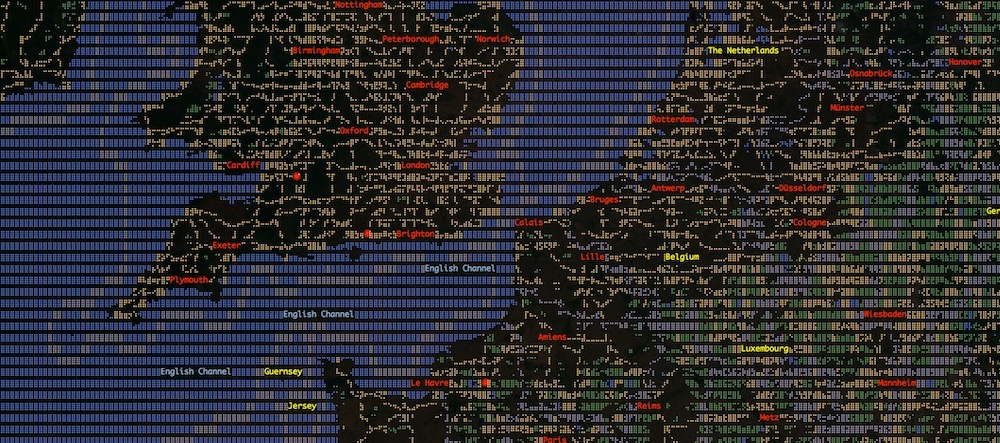
I even tried it from a console on an EC2 instance I’ve got. A quick telnet command gets you connected, a and z keys to zoom, arrow keys to pan:
telnet mapscii.me
Funnily enough, I could even see this being useful if you needed to reference a map while on a command line on a remote server. Mostly it’s a clever toy, but impressive nonetheless.
This is an absolutely phenomenal project showcasing each of the major satellites in the Solar System. The full interactive maps of each one are incredible. It shows how much data we’ve gathered about all of these bodies with imagery on each one and thoroughly mapped with place and feature names.
A cool piece of news here. We bought our house with Redfin and had a great experience with it, after using the website heavily during the house search process. Opendoor is also in the real estate space, but their core business is around buying up properties themselves, offering easy liquidity to homeowners needing a rapid sale. I like that Redfin sees the potential there. Hopefully it’s a good fit for each business.
The study found that walking indoors or outdoors similarly boosted creative inspiration. The act of walking itself, and not the environment, was the main factor. Across the board, creativity levels were consistently and significantly higher for those walking compared to those sitting.
I definitely feel like many of my best ideas and possible problem solutions come to me while running. This research shows that the act of cardiovascular activity spurs something creatively that you don’t have while sitting.
Zoom is one of those admirable SaaS companies built on solid product and amazing execution. I love this — not relying on anything sexy or super inventive, just solving a known problem better than everyone else. My favorite bit is their retention; it proves what can be done even in SMB with lock-tight product market fit:
Zoom has 140% net revenue retention. This is similar to RingCentral from our last analysis and other leaders. Zoom also shows that yes, this can be done with smaller customers too, not just enterprises.
This is a great quick animation showing the sun’s path across the globe during the summer solstice. It shows very clearly why, as you move toward northern latitudes in the summer you get such long days, with perpetual sunlight above the Arctic Circle.
The TeachOSM crew has been doing grest work training teachers how to use OpenStreetMap in their classrooms. Geographic education is critical, especially in primary education, to form a baseline understanding of the world. I got to help out at one of these workshops last year and the outcomes were truly impressive.
Since 2016, TeachOSM has trained ~350 teachers and vocational educators in open mapping techniques. So giving open mapping workshops for teachers has become a staple of our programming over the last few years. In this post, I briefly outline what we do in our workshops, why it is vital work, and how you can help us to make OSM available in geography classes everywhere.
Our friend and colleague Kurt Menke of Bird’s Eye View GIS recently conducted a workshop in Hawaii working with folks from the Pacific Islands (Samoa, Marianas, Palau, and others) to teach Fulcrum data collection and QGIS for mapping. Seeing our tech have these kinds of impacts is always enjoyable to read about:
The week was a reminder of how those of us working with technology day-to-day sometimes take it for granted. Everyone was super excited to have this training. It was also a lesson in how resource rich we are on the continent. One of my goals with Bird’s Eye View is to use technology to help make the world a better place. (Thus my focus on conservation, public health and education.) One of the goals of the Community Health Maps program is to empower people with technology. This week fulfilled both and was very gratifying.
Most of the trainees had little to no GIS training yet instantly knew how mapping could apply to their work and lives. They want to map everything related to hurricane relief, salt water resistant taro farms, infrastructure related to mosquito outbreaks etc. A benefit of having the community do this is that they can be in charge of their own data and it helps build community relationships.
At the recent WWDC, Apple announced an overhaul to their Maps product, including millions of miles of fresh data from their vehicle fleet, along with a new Street View-like feature called “Look Around”. Even though it’s exciting to see them invest in mapping, it seems like a bridge too far to ever catch the quality of Google Maps. Om Malik compares the relative positions between the two to that of Bing to Google in search. Apple is approaching Maps as an application first, when really maps are about data:
Why do I think Google Maps will continue to trump Apple despite the latter’s fancy new graphics and features? Because when it comes to maps, the key metrics are navigation, real-time redirection, and traffic information. Google’s Waze is a powerful weapon against all rivals. It has allowed Google to train its mapping algorithms to become highly effective and personal (not to mention how much intelligence that might have been shared with Waymo).
I would add point of interest data to this list as a key metric. That used to be purchased from commercial providers, scraped from the internet, and mapped manually, but now the fleet of vehicles (and Google’s users searching for places) provide a continuous stream of validation and updates to place data. With the combination of Google Maps, the Android OS, and soon a fleet of autonomous Waymo vehicles, it seems like Google will continue to be an unstoppable data juggernaut.
Paul Ramsey considers who might be in the best position to challenge Google as the next mapping company:
Someone is going to take another run at Google, they have to. My prediction is that it will be AWS, either through acquisition (Esri? Mapbox?) or just building from scratch. There is no doubt Amazon already has some spatial smarts, since they have to solve huge logistical problems in moving goods around for the retail side, problems that require spatial quality data to solve. And there is no doubt that they do not want to let Google continue to leverage Maps against them in Cloud sales. They need a “good enough” response to help keep AWS customers on the reservation.
Because of mapping’s criticality to so many other technologies, any player that is likely to compete with Google needs to be a platform — something that undergirds and powers technology as a business model. Apple is kinda like that, but nowhere near as similar to an electric utility as AWS is.
With the release of the amazing new Mac Pro and other things announced at WWDC, it’s clear that Apple recognizes its failings in delivering for their historically-important professional customers. Marco Arment addresses this well here across the Mac Pro, updates to macOS, iPadOS, and the changes that could be around the corner for the MacBook Pro.
I’m excited to get iPadOS installed and back to my iPad workflow. This is a good comprehensive overview from Shawn Blanc, someone who has done most of his work on an iPad for a long time.
This is a neat interactive tool to visualize distortion due to map projection using Tissot’s indicatrix, a mathematical model for calculating the amount of warp at different points:
Nicolas Auguste Tissot published his classic analysis on the distortion on maps in 1859 and 1881. The basic idea is that the intersection of any two lines on the Earth is represented on the flat map with an intersection at the same or a different angle. He proved that at almost every point on the Earth, there’s a right angle intersection of two lines in some direction which are also shown at right angles on the map. All the other intersections at that point will not intersect at the same angle on the map, unless the map is conformal, at least at that point.
A typeface designed to mimic the National Park Service signs that are carved using a router bit.
Perfect timing on finding this one. I’ve been working on a cartography project to simulate a USGS-style topographic map in QGIS, and this could work perfectly in that design. Excellent work from the Design Outside Studio.
SpaceX is developing a space-based broadband internet system of 24 satellites. The design of this hardware looks incredible. I hope it gets traction and sparks a consumerization of this sort of tech. Between projects like this and the work of Planet and others with microsatellites, that industry seems like it’s on the cusp of some big things.
Our place for today I found via NASA’s Earth Observatory feed: the Great Slave Lake of the Canadian Northwest Territory.

While it’s a big body of water when you pan over it on the map, it’s size is hard to fathom when compared to other geographic features:
If you are traveling on Canada’s Great Slave Lake, you will notice one characteristic right away: it is enormous. Roughly the size of Belgium, it ranks in the top fifteen largest lakes worldwide. It is the deepest lake in North America, diving about 615 meters (2,020 feet)—almost the same extent as the world’s second tallest building, the Shanghai Tower.
It’s strange to imagine that you could be on a body of water that’s oceanic in size, miles out of sight of land, but in the middle of the remote Canadian wilderness. The glaciated scarring of the Simpson Islands on the east side must be truly impressive in person. Massive rocks and hundreds of tiny islands dotting the deep water.
I would bet that, if polled, most people would have no idea that 2 of the 10 largest lakes in the world are in Canada. The Great Bear Lake further north is even larger!
The Great Slave Lake :: 61°40' N, 114° W
Love to see the Rays getting some deserved attention in the mainstream sports media. They’ve put together a great, diverse lineup of consistent hitters that have performed well all season:
The Rays emphasize power now, but in a different way: Through Monday, their hitters had the highest exit velocity in the majors, at 90.1 miles per hour, and their pitchers — who specialize in curveballs and high fastballs — allowed the lowest, at 86.3. Hard-contact rates enticed them to trade for Pham from St. Louis last July, and to land Yandy Diaz in an off-season deal with Cleveland. Pham was hitting .248 for the Cardinals, but the Rays assured him he had simply been unlucky; he hit .343 the rest of the season.
And I get to post this on the back of their 11th inning win over the Yankees this afternoon.
Great quick read from Horace Dediu on Apple’s Services business. As he points out in the piece, Apple’s business model is continually oversimplified and/or misunderstood by many:
This disconnect between what people think Apple sells and what Apple builds is as perplexing as the cognitive disconnect between what companies sell and what customers buy.
Companies sell objects or activities that they can make or engage in but customers buy solutions to problems. It’s easy to be fooled that these are interchangeable.
Conversely Apple offers solutions to problems that are viewed, classified, weighed and measured as objects or activities by external observers. Again, it’s easy to be fooled that these are the same.
This post goes into how the author put together a visualization of tornado trend data for Axios. Observable notebooks are so great. The interactivity lets you not only see the code and data to create it all, but can be forked and edited right there.
Yesterday evening I attended a community meeting in our neighborhood on the tidal resiliency plan the City of St. Pete is putting together to combat the periodic street flooding we get during high tidal or rainfall events.
The city planning folks in attendance were showing maps of the neighborhood and projected areas of high water during these events. The crux of the issue in Shore Acres is that during spring tides, water from the bay pushes back up the storm drain pipes and comes out the streetside storm drains in some of the lower intersections in the neighborhood. Parts of Shore Acres are like a bowl — the inside actually lower than the outer rim. With such low elevation all around, even a couple inches of difference can mean water covering the entire roadway or a homeowner’s yard.
Streets around our house can get bad:
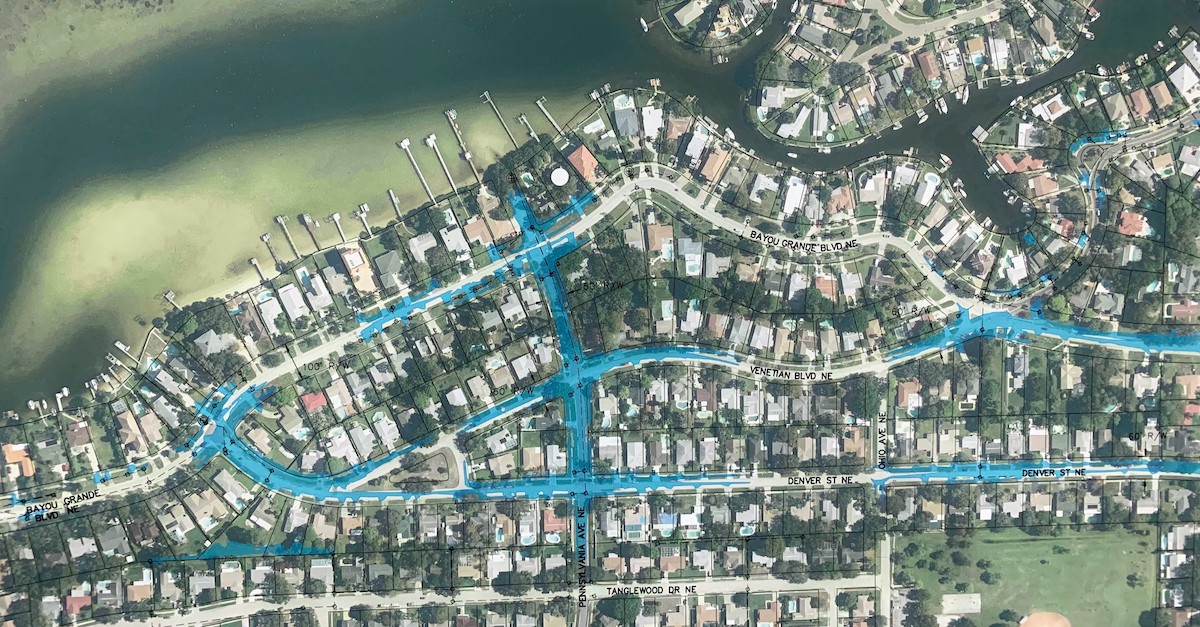
This graphic makes it look worse than it usually is. Even in high tide + high rainfall combo events, it isn’t this extreme. This is a projection of 30+ year storm events. It does definitely get wet out there, though.
With all of the studies and survey work they’ve done the past few years, the group presented a host of projected improvements that could be done to alleviate the problem — including bioswales, roadway elevation, force mains, pump stations, and even some aquatic plants (grasses, mangroves) out on the sand flats to reduce wave action.
Near our house would be a little bit of everything, if most of the plan goes through. I’m sure they’ll only end up doing a small fraction of the most critical improvements. The full scope of proposed options looks expensive. Most importantly, near the worst of the flooding on our route out of the neighborhood, they’ve proposed a pump station and force main to be installed in a piece of public land in the intersection:
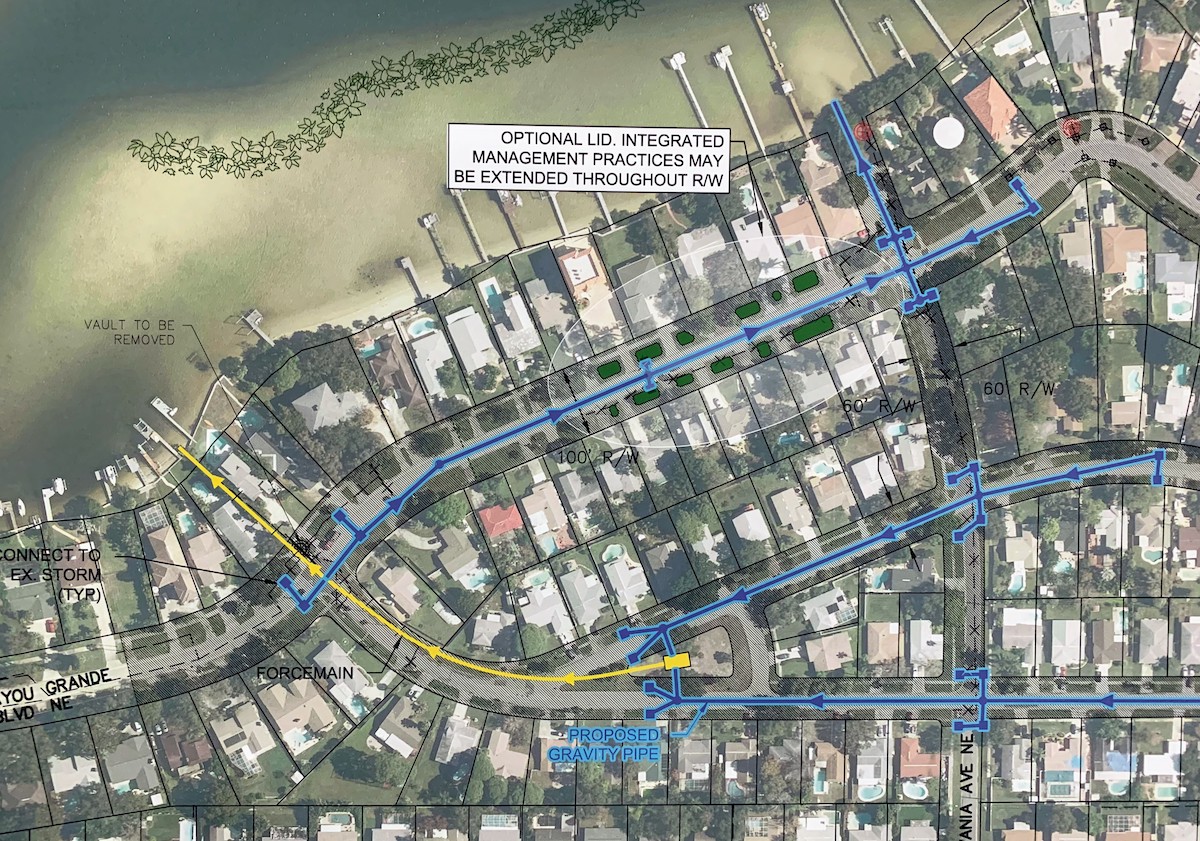
This would be a major overhaul to a decades-old problem of street flooding in Shore Acres. A long overdue bunch of improvements to keep everyone safe and able to get out of the neighborhood if needed.
The City’s overview map of the area really shows why this is a problem. The entire neighborhood was once an estuarine marsh that was essentially converted into manmade “islands”.
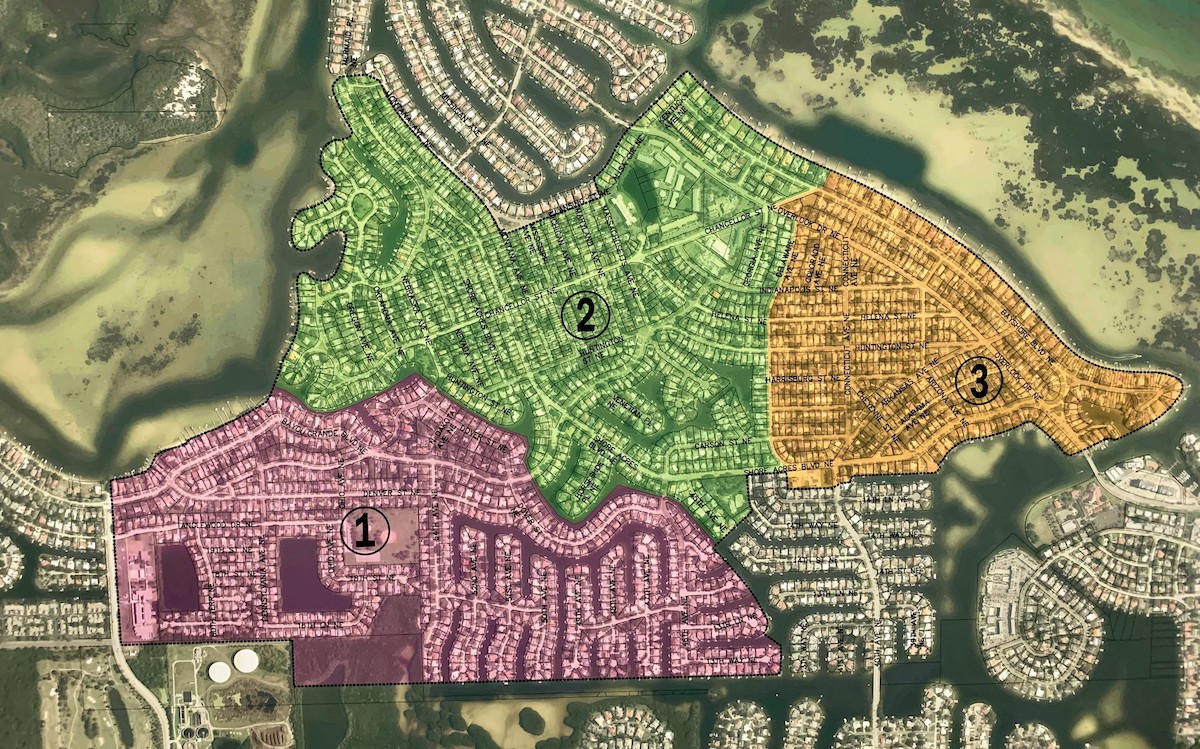
The lesson: it’s hard to fight mother nature.
One of my favorite open source projects ongoing right now is OpenDroneMap. I haven’t gotten to use it much recently, but followed development over the last couple years. Outside of some loose testing a while ago, I haven’t flown my Mavic for any imagery collection since. I need to go out to the waterfront nearby and fly some new data so I can kick the tires some more on ODM’s latest stuff.
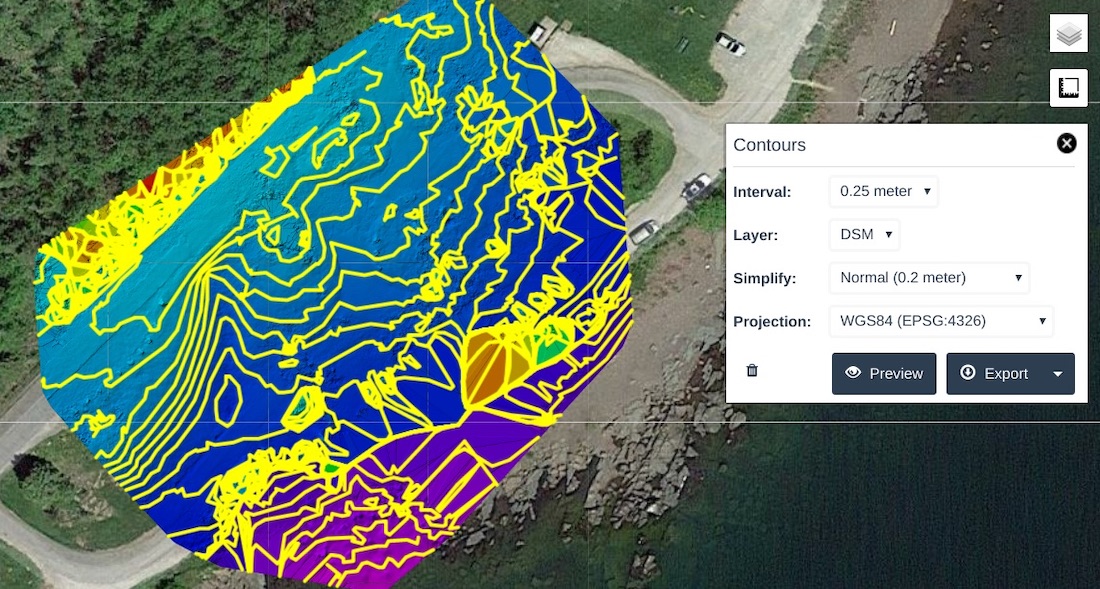
Piero just announced completion of contour support in WebODM, which is the web front-end to the ODM processing suite. This is some powerful geospatial software, and a great example of what a committed team can do with open source. The new contour capability leverages the GRASS engine as well as GDAL to process, then allows you to export to GIS. I can’t wait to try it out.
Found via Tom MacWright, a slick and simple tool for doing run route planning built on modern web tech. It uses basic routing APIs and distance calculation to help plan out runs, which is especially cool in new places. I used it in San Diego this past week to estimate a couple distances I did. It also has a cool sharing feature to save and link to routes.
I mentioned scientist Vannevar Bush here a few days back. This is a piece he wrote for The Atlantic in 1945, looking forward at how machines and technology could become enhancers of human thinking. So many prescient segments foreshadowing current computer technology:
One can now picture a future investigator in his laboratory. His hands are free, and he is not anchored. As he moves about and observes, he photographs and comments. Time is automatically recorded to tie the two records together. If he goes into the field, he may be connected by radio to his recorder. As he ponders over his notes in the evening, he again talks his comments into the record. His typed record, as well as his photographs, may both be in miniature, so that he projects them for examination.
I thought this was an excellent rundown of remote work, who is suited for it, how to manage it, and the psychology of this new method of teamwork.
Let’s first cover values. Remote work is founded on specific core principles that govern this distinct way of operating which tend to be organization agnostic. They are the underlying foundation which enables us to believe that this approach is indeed better, more optimal, and thus the way we should live:
- Output > Input
- Autonomy > Administration
- Flexibility > Rigidity
These values do not just govern individuals, but also the way that companies operate and how processes are formed. And like almost anything in life, although they sound resoundingly positive, they have potential pitfalls if not administered with care.
I found nearly all of this very accurate to my perception of remote work, at least from the standpoint of someone who is not remote, but manages and works with many that are. I’m highly supportive of hiring remote. With our team, we’ve gotten better in many ways by becoming more remote. And another (perhaps counterintuitive) observation: the more remote people you hire, the better the whole company gets and managing it.
“It may seem surprising but, in terms of digital media storage, our knowledge of language almost fits compactly on a floppy disk,” the authors wrote in the study. In this case, that would be a floppy disk that holds about 1.5 megabytes of information, or the equivalent of about a minute-long song as an Mp3 file. [3D Images: Exploring the Human Brain] The researchers estimate that in the best-case scenario, in a single day, an adult remembers 1,000 to 2,000 bits of their native language. In the worst-case scenario, we remember around 120 bits per day.
My friend and co-worker Joe Larson has been doing some cool experiments with Blender for generating hillshades, jumping off of work from Andy Woodruff, Daniel Huffman, and Scott Reinhard. I’ve seen a few different hillshade / topo composites that look super cool.
Nassim Taleb’s concept of “antifragility is a fascinating philosophical framework; one which I’ve linked to and mentioned here before. This Farnam Street post summarizes 10 thinking concepts to help orient your own life and decision making toward antifragility:
In short, stop optimizing for today or tomorrow and start playing the long game. That means being less efficient in the short term but more effective in the long term. It’s easy to optimize for today, simply spend more money than you make or eat food that’s food designed in a lab to make you eat more and more. But if you play the long game you stop optimizing and start thinking ahead to the second order consequences of your decisions.
I love this piece — a detailed analysis, backstory, and new map of Odysseus’s supposed voyages around the Mediterranean:
In 1597 the cartographer Abraham Ortelius became the first person to draw a map of Odysseus’ travels. Like many Homeric geographers, Ortelius identifies Scheria, home of the Phaeacians, with Corcyra (now known as Corfu) because of a passage from Thucydides’ History of the Peloponnesian War claiming the Phaeacians were the previous inhabitants of that island. While widely accepted, this identification of Scheria with Corcyra creates a problem. Homer clearly places Calypso’s island west of Scheria, but there is no island in the Ionian Sea west of Corcyra. Ortelius, following in the footsteps of Pliny, mapped a nonexistent island off southern Italy and called it the home of Calypso. The imaginary island appeared on maps through the mid-nineteenth century, and individuals continued to search for it into the twentieth. (Perhaps it had sunk into the sea?)
Geographers for thousands of years have been attempting to reconstruct the trail.
I wrote up a post for the Fulcrum blog on using OpenAerialMap with Fulcrum Community. As we invest more in building out our Community platform this year, I’m excited to do more with integrating OAM into our tools.
For response deployments using Fulcrum Community, you can also add OpenAerialMap datasets to your Fulcrum account as layers to use in the Fulcrum mobile app.
Using Fulcrum’s map layer feature, you can add OAM datasets using the “Tile XYZ” format. These layers also become available on the mobile app, so contributors on the ground doing damage assessment, for example, can have access to current, high-resolution data for reference. OAM also makes data available in WMTS, and integrates directly with the iD editor and JOSM OpenStreetMap editing tools to simplify tracing buildings, roads, and water bodies.
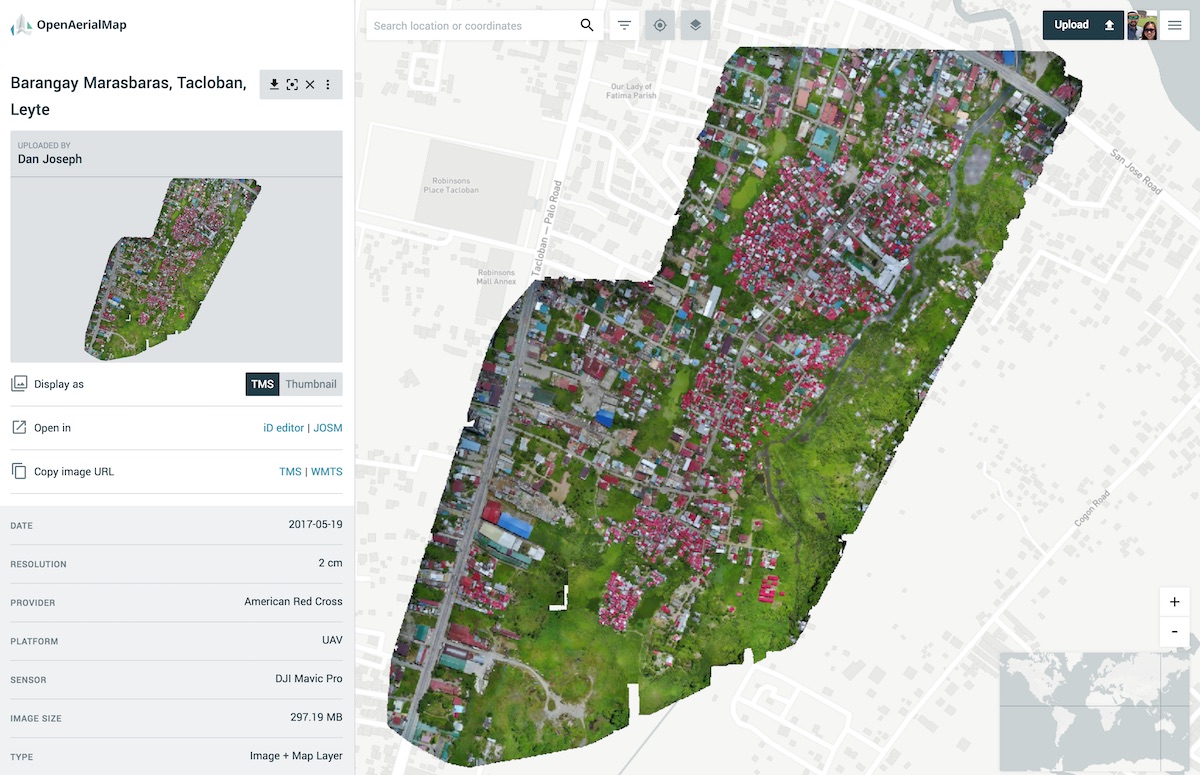
Mapbox has built this curated dataset of administrative boundaries from country level down to local geographic units like arrondissements, prefectures, and districts. Knowing how difficult it is to aggregate and clean up all this different datasources into a single cohesive product, this is an impressive dataset that they’re providing through their developer tools for geocoding and joining to other data. Browse the dataset on this interactive map.
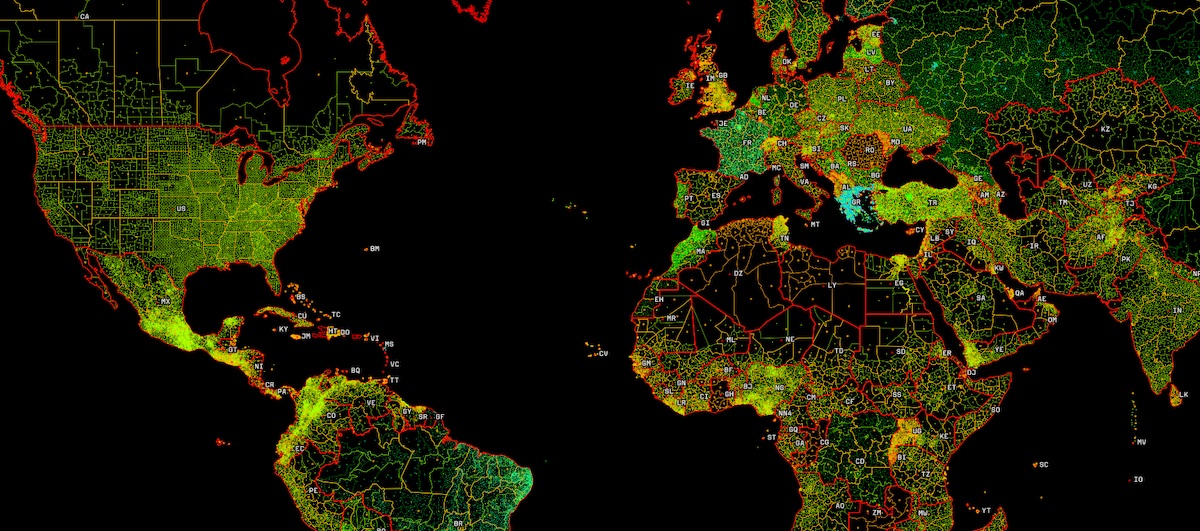
Tom Patterson has released a new version of his Equal Earth Map, this time as a physical topographic map style. Beautiful stuff.
This is a great breakdown of the different elements of LiDAR technology, looking at three broad areas: beam direction, distance measurement, and frequencies. They compare the tech of 10 different companies in the space to see how each is approaching the problem.
Taking off of the Wikibooks project, this team is aiming to generate books from Wikipedia content using ML techniques.
Given the advances in artificial intelligence in recent years, is there a way to automatically edit Wikipedia content so as to create a coherent whole that is useful as a textbook? Enter Shahar Admati and colleagues at the Ben-Gurion University of the Negev in Israel. These guys have developed a way to automatically generate Wikibooks using machine learning. They call their machine the Wikibook-bot. “The novelty of our technique is that it is aimed at generating an entire Wikibook, without human involvement,” they say.
This simple app lets you slide from the Jurassic to the Holocene. A vivid demonstration of how long 200 million years really is.
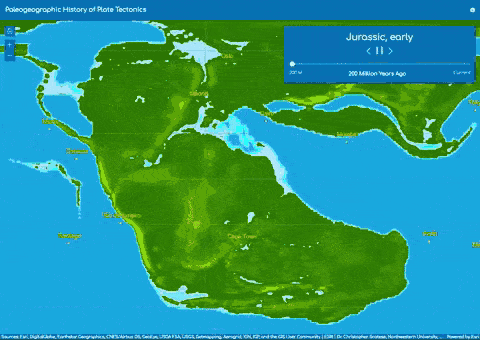
In the spirit of yesterday’s post on the Earth of the past, this interactive map lets you browse back in time to see what oceans and landmasses looked like all the way back to 750 million years ago. Try typing in your address to see if you’d have been a resident of Gondwana or Laurasia if you took your time machine back to the Triassic.
When I read Annals of the Former World some years back, the hardest thing to wrap my head around with geologic time was the sheer scale of what “100 million years” looks like. No matter how many of the comparisons, scale bars, or timelines I see, it’s still mind-blowing to think about continents converging, separating, and reconverging repeatedly throughout history.
Every year since the pre-Stone Age area, visualized as a time lapse on a map.
This is amazing and puts into context what was developing where over time. I know when I read the history of one culture, like Ancient Greece, it’s hard to keep in the mind what was happening elsewhere in the world during the same time period. This video could be a good reference point to pull up to get a sense of what happened during, before, and after any period in human history.
It’s also hard to believe that in 3000 BC the global population estimate was only 30 million people, or roughly the population of modern Nepal.
This excellent guide shows how to combine take imagery from OpenAerialMap and buildings from OpenStreetMap, and combine to train a model for automated feature extraction. It uses an open source tool from Mapbox called RoboSat combined to compare a GeoTIFF from OAM with a PBF extracts from OSM. Very cool to have a generalized tool for doing this with open data.
An excellent roundup (with tons of ancillary linked sources) on the state of various parts of computer security, from programming, to browsers, to social engineering.
From Tom Patterson, the Equal Earth map uses the equal earth projection to show countries with their true relative sizes. No more ginormous Russia or Africa-sized Greenland.
In this latest cartography project I’m working on, I’m rediscovering the tedium of searching for appropriate data. I’ll grant that it’s amazing how much high quality data is produced and freely distributed, but given the advances of web technology, it’s frustrating to see how bad many of the web map content management systems are.
Of course the difficulty of finding data depends on the geographic area. I happen to be working on a region that’s pretty sparse, so some data (like rasters) can be harder to find.
Here are a few resources I’ve either found or rediscovered worth sharing:
Another thing this project has prompted is a revivifying of my gazetteer project for working with GeoNames data1. The dataset has evolved in format and been updated since I last touched this tool in ~2013, so I had to make some changes to get it to work again. Since GeoNames is delivered in a raw text format, the goal of this tool is to automate loading the data into PostGIS for easier, faster use in QGIS.
This deserves a full post at some point later. I’ve always had a soft spot for place name data, so more attention on GeoNames and tools for working with it is worth it. ↩
I’m working on a special side project right now, getting myself back into cartography a bit. The last time I did any serious cartography work was with TileMill, probably 4 or 5 years ago. This time I’m trying my hand with QGIS to see what I can do.
For part of this project I wanted topographic maps, for both data and design inspiration. I was reminded of this excellent tool for browsing and downloading the archive of historical topo maps from the USGS. I have no idea why this isn’t the primary interface for the National Map, but I’m glad it exists. It makes searching and downloading the data so much simpler.
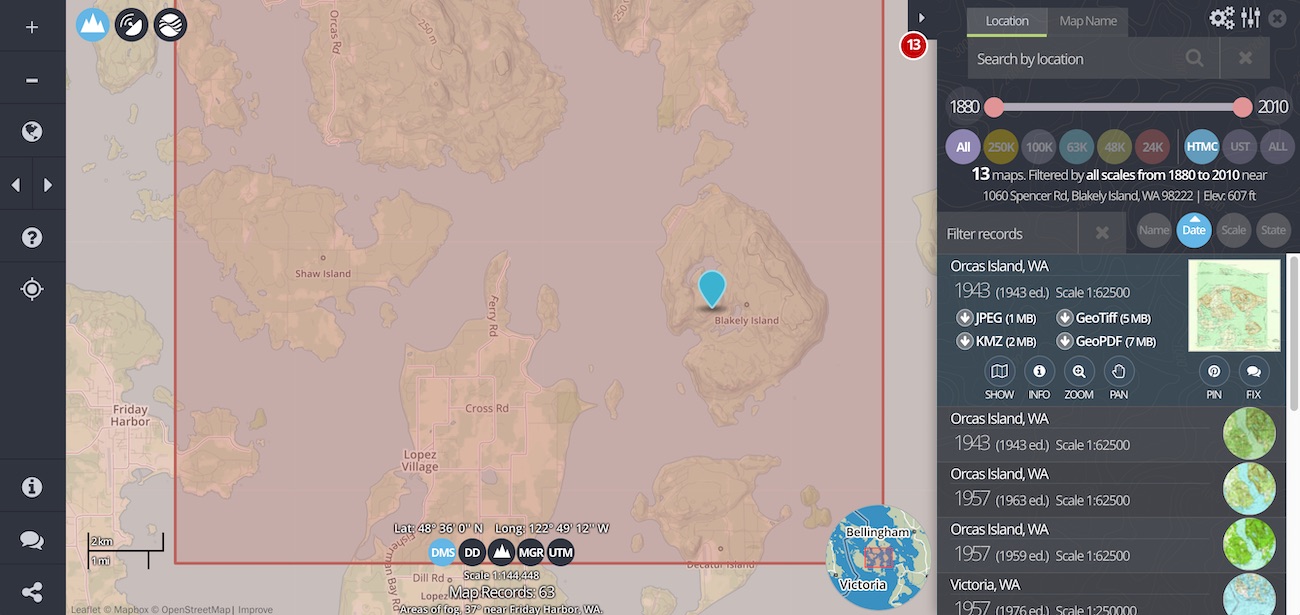
Soon I’ll reveal some progress on this project.
Each year GIS developer and cartographer Nyall Dawson puts together a thread of daily tweets leading up to Christmas, each with a helpful tip for QGIS. You can see all of them at the hashtag #24daysofqgis.
Here are a few of my favorites:
Day 8: Use the handy #QGIS Ctrl+F6 shortcut to open an attribute table containing only visible features, and Shift+F6 for a table containing only selected features. #24daysofqgis pic.twitter.com/ko1iIuxTvL
— North Road (@northroadgeo) December 8, 2018
Day 11: Use a mouse right-button click with the #QGIS identify tool to show a handy menu allowing identification of features from ALL map layers at the clicked coordinate! #24daysofQGIS pic.twitter.com/G1SFQPUxml
— North Road (@northroadgeo) December 11, 2018
Day 15: Type "f" in the #QGIS locator bar (that search widget down in the status bar) followed by a keyword to search for and quickly locate features from the current layer. #24daysofqgis pic.twitter.com/ZubulXrdJM
— North Road (@northroadgeo) December 15, 2018
This week is some reading, but some simple admiring. I wanted to highlight the work of two cartographers I follow that is fantastic. We live in a great world that people can still make a living producing such work.
A beautiful, artistic work from David Garcia sorting each island’s landmass by area. My favorite map projects aren’t just eye candy, they also teach you something. I spent half an hour on Wikipedia reading about a few of these islands.
This is a project from cartographer Daniel Huffman using a combination of open datasets, projection twisting, meticulous design, and Illustrator skills. The finished product is really amazing. The attention to detail is stunning. I love the detailed step-by-step walkthrough on how it came together.
A library of vector graphics for cartographic design. Each one has a unique style and could be used in other products, since it’s public domain (awesome). This is another cool thing from Daniel Huffman.
Both of these guys do amazing work. Find more on their websites:
Borders in today’s world are remarkably static, ever-present lines we all get used to separating territories as if there are hard barriers to interaction between the multicolored countries of your average political map of the world. Centuries of perpetual war, invasions, treaties, intermarrying monarchs, imperialism, and revolutions redrew the global map with regularity, but today we don’t see this level of volatility. When a new country is formed, a disputed territory shifts, or a country is renamed, it makes global headlines. It’s only every few years that you see territorial shifts.
This level of stability can be attributed to the interconnectedness of modern global society. In Connectography, Parag Khanna makes a compelling case for the dissolving relevance of international borders. His thesis is that cities are now the dominant focal point of human engagement and productivity rather than states, and that the grid of connection points between cities has largely superseded the importance of international borders: “a future shaped less by national borders than by global supply chains, a world in which the most connected powers—and people—will win.”
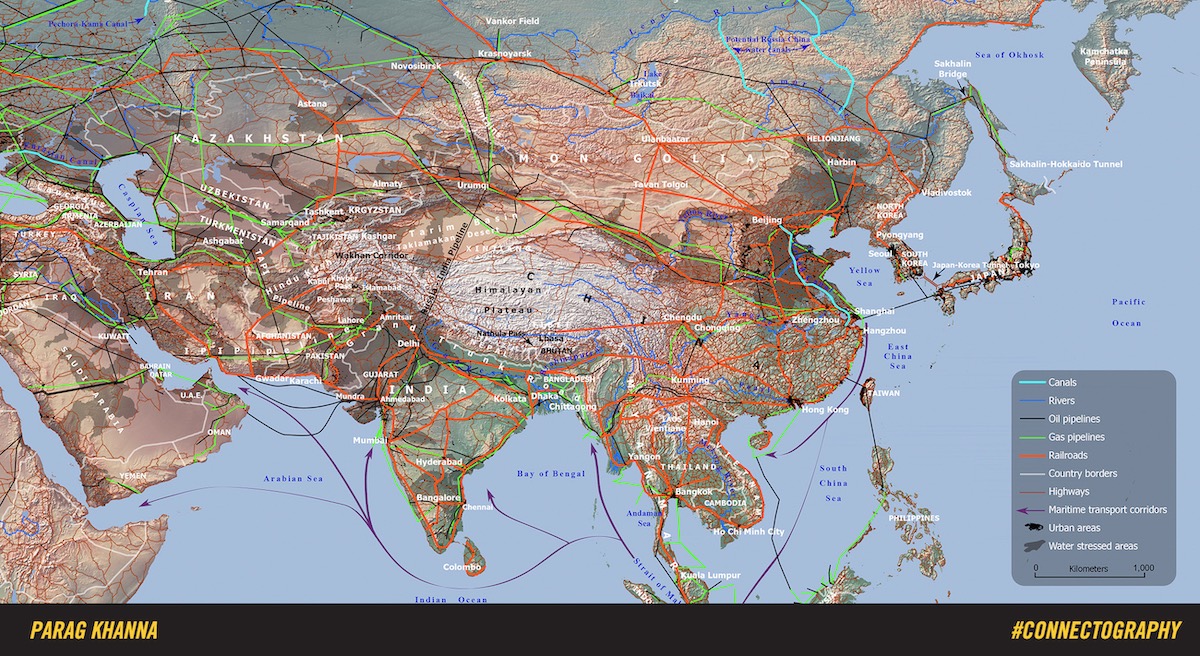
Worldwide economic growth has created a level of stability unprecedented in human history. In Thomas Friedman’s 1999 book The Lexus and the Olive Tree, he posits the “Golden Arches Theory” — that “no two countries that both had McDonald’s had fought a war against each other since each got its McDonald’s.” Meaning once economies are significantly integrated with one another, the cost of conflict increases, thereby deterring each side from sparring with one another. While this tongue-in-cheek theory offers an overly simplistic view of the world, the point still largely holds up today. Nations go to “economic war” more readily than armed conflict.
Expanding on Friedman’s theory from 20 years ago, Khanna clarifies that it isn’t specific enough to attribute stability to “globalization” in some broad sense. More concretely, it is interconnectedness that creates a shared sense of motivation, collaboration, and responsibility for progress. As he points out, some of the least connected places on earth are the ones with the least stability:
“Importantly, the geographies not knitting themselves together into collective functional zones—the Near East and Central Asia—are also generally where one finds the most failed states.”
The concept of “global cities” started to take hold in the nineties — cities that function as nodes on the global interconnected network thanks to the connective tissue of infrastructure: Shanghai, New York, London, Singapore, Hong Kong, and others. Modern telecommunications, energy distribution, and transportation networks wire people closely together while ignoring the man-made boundaries between nations, the social barriers of language and culture, and even the physical barriers in mountains and oceans. Khanna makes the case that we should redraw our maps to more vividly represent reality on the ground:
“The absence of the full panoply of man-made infrastructure on our maps gives the impression that borders trump other means of portraying human geography.”
With increasing human migration to to urban areas, the city is where human activity now takes place. Cities (especially global ones) are beginning to form economic and diplomatic bonds with one another, regardless of the proximity or cultural similarity of their respective states. Central to Khanna’s point is that this economic and technological expansion has enabled supply chains to drive the social order:
“Supply chains are self-assembling and organically connecting. They expand, contract, shift, multiply, and diversify as a result of our collective human activity. You can disrupt supply chains, but they will quickly find alternative pathways to fulfill their missions.”
Globalization and the ever-multiplying division of labor allows for even historically landlocked places excluded from the global economy to specialize and “plug into” the network, taking their place in the flexible supply chain. The competition to become a new link in the supply chain creates positive forces that motivate people to create value for others up the chain. What used to be a hierarchical order between large states has dissolved into hundreds or thousands of largely-independent nodes that invest in their own specialties, a decentralization that reworks the old world order:
“The interstate puzzle thus gives way to a lattice of infrastructure circuitry. The world is starting to look a lot like the Internet.”
One focal point of the book is on the policy tactics cities are using to embrace connection and openness within their current constraints of monarchy or centralized control. The “Special Economic Zone” (SEZ) is a tool in the arsenal gaining acceptance around the world to invite foreign investment in the form of corporate presence inside of a nation’s borders. As Khanna points out, they’re gaining in popularity with “more than four thousand SEZs around the world, the pop-up cities of a functional supply chain world.” Acting as if there’s little to no barrier to collaborative development, a US-based company can establish a presence in Shenzhen, Dubai, or Batam that was impossible 20 or 30 years ago. Powered by the infrastructural connections brought about by the internet, containerized shipping, and international financial investments, these SEZs provide havens for countries to ignore one another’s political boundaries. In places like China’s Pearl River Delta, this interconnectedness with other global cities has enabled unprecedented growth — now with nearly 60 million people plugged into an economy by leveraging its network proximity to the other centers of gravity, like a critical router in a network topology diagram. The savvy of the local government in attracting multinational corporate investment (even though counter to much of the party dogma) can be credited with an enormous jump in quality of life for millions of former rural Chinese that have since migrated to the region.

The book is full of rich examples of locales as diverse as colonial Southeast Asia, the Caucasus, the Near East, and East Africa. A theory this compelling on modern economic freedom and progress requires connecting the dots of history to understand how we arrived here. Throughout the book there are maps peppered in to visualize the pervasiveness of infrastructural connection. There’s even a website devoted to making the maps interactive, so you can see for yourself how interconnected the world already is, regardless of political rhetoric of the day.
Connectography is an engaging read for anyone interested in geopolitics, international relations, and geography. Khanna has developed a thought-provoking theory of economic development for the modern era.
Some fun facts from the book:
For more on Khanna’s work on Connectography, check these out:
With tools like Mapillary and OpenStreetCam, it’s pretty easy now to collect street-level images with a smartphone for OpenStreetMap editing. Point of interest data is now the biggest quality gap for OSM as compared to other commercial map data providers. It’s hard to compete with the multi-billion dollar investments in street mapping and the bespoke equipment of Google or Apple. There’s promise for OSM to be a deep, current source of this level of detail, but it requires true mass-market crowdsourcing to get there.
The businesses behind platforms like Mapillary and OpenStreetCam aren’t primarily based on improving OSM. Though Telenav does build OSC as a means to contribute, their business is in automotive mapping powered by OSM, not the collection tool itself. Mapillary on the other hand is a computer vision technology company. They want data, so opening the content for OSM mapping attracts contributors.
I’ve been collecting street-level imagery for years using windshield mounts in my car, typically for my own purposes to add detail in OSM. Since we launched our SpatialVideo feature in Fulcrum (over 4 years ago now!), I’ve used that for most of my data collection. While the goals of that feature in Fulcrum are wider than just vehicle-based data capture, the GPS tracking data with SpatialVideo makes it easier to scrub through spatially to find what’s missing from the map. My personal workflow is usually centered on adding points of interest, but street furniture, power infrastructure, and signage are also present everywhere and typically unmapped. You can often see addresses on buildings, and I rarely find new area where the point of interest data is already rich. There’s so much to be filled in or updated.
This is a quick sample of what video looks like from my dash mount. It’s fairly stable, and the mounts are low-cost. This is the SV player in the Fulcrum Editor review tool:
One of the cool things about the Fulcrum format is that it’s video, so that smoothness can help make sure you’ve got each frame needed — particularly on high speed thoroughfares. We built in a feature to control the frame rate and resolution of the video recording, so what I do is maximize the resolution but drop the frame rate well below 30 fps. This helps tremendously to minimize the data quantity that’s got to get back to the server. Even 3 or 5 fps can be plenty for mapping purposes. I usually go with 10 or so just to smooth it out a little bit; the size doesn’t get too bad until you go past 15 or so.
Of course the downside is that this content isn’t available to the public easily for others to map from. Not a huge deal to me, but with Fulcrum Community we’re looking at some ways to open this system up to use for contribution, a la Mapillary or OSC.
A great interview with Bret Victor on the Track Changes podcast. His work has always been an inspiration for how to think about both creating things and teaching people.
This post from Caitlin Hudon is a great reminder for anyone that works with data. Combining git versioning with your SQL is super helpful for archiving and searching previous analysis queries.
- You will always need that query again
- Queries are living artifacts that change over time
- If it’s useful to you, it’s useful to others (and vice versa)
I love the map and exploration of Skyrim. As an artistic achievement, the map there isn’t as eye-catching as Grand Theft Auto, the Ultima games, or even previous Elder Scrolls games. But I love the unlabeled overhead picture of the world that forces you to get out and walk to find your way.
The absolute piece de resistance of a game world map has to be the continent of Tamriel for The Elder Scrolls. People have tried to wrangle Skyrim’s map into submission with mods and interactive versions of it, but it fundamentally is a map that doesn’t explain itself to you or aspire to be particularly helpful. The world is what it is - now you have to go and find your way across it.
This is the first book review post since I put up my library section. I hope to do more of this in the future with each new book I add to the collection. Enjoy.
The Story of Maps took me a while to get through, but it’s the most comprehensive history I’ve seen on the history of geography and cartography.
Of particular note was the history of the figures in antiquity, their discoveries, and the techniques they used to advance the science of mapmaking. From Strabo, Eratosthenes, and Ptolemy to Ortelius, Mercator, and Huygens, Brown is extremely thorough in giving each of the critical figures their space on the page. The book is peppered with illustrations that give visual context to many of the maps and equipment devised by the cartographers, scientists, and inventors. I found myself down numerous Wikipedia rabbit holes whenever I’d see arcane place names in the periphery of the worlds known to the Greeks, Romans, or Carthaginians.
Naturally I had a good understanding of how most geographical systems and tools work — longitude and latitude, equinoxes, the tropics, time zones. What was a delight to read was the historical context in which these things were discovered or developed by people with little to no access to anything we’d consider “technology.” For millennia, making maps meant getting on a ship, horse, camel, or your feet, writing down what you saw, observing celestial patterns in the sky (or Jupiter if you were really clever), and tediously aggregating enough detail to make a representative picture of the world. Today we laugh at the distorted, backward views that scientists like Strabo assembled as his “known world,” but given the available resources, it’s honestly stunning anyone could map anything beyond their own village.
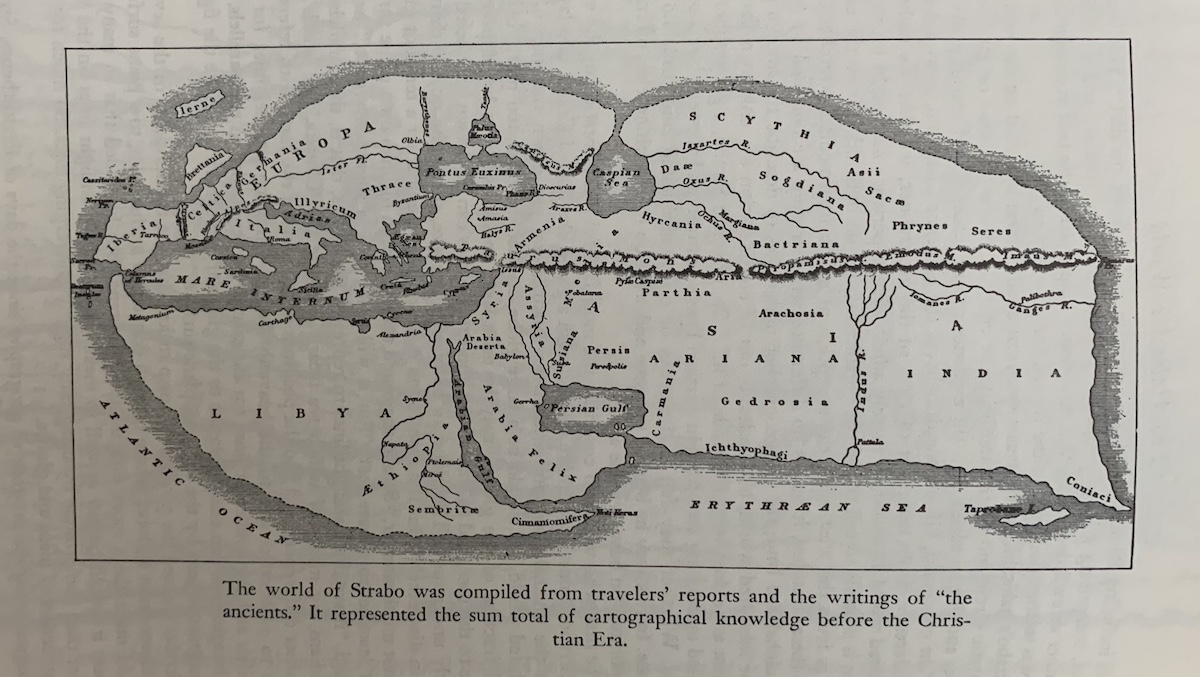
Brown addresses this in the introduction, that the history of science is one of failure and persistence:
The history of science as a whole is the record of a select group of men and women who have dared to be wrong, and no group of scientists has been more severely criticized for its errors than cartographers, the men who have mapped the world. Hundreds of weighty tomes have been written to prove how very wrong were such men as Ptolemy, Delisle, and Mitchell. For every page of text, for every map and chart compiled by the pioneers of cartography, a thousand pages of adverse criticism have been written about them by men who were themselves incapable of being wrong because they would never think of exposing themselves to criticism, let alone failure.
As cartoonish and silly as most maps made prior to the Renaissance appear, the historical frame Brown assembles around these works gives a great appreciation to the struggles of the pre-modern cartographer’s reality.
For most of human history, the map of the world was really one of the Mediterranean Sea. We’ve all seen ancient maps with extreme distortion beginning only a few hundred miles from the Med coast. One of my favorite sections of the book is about the Phoenician pioneering of navigation and sea charts, one of the earliest forms of map that had practical use beyond the artistic. Rather than an academic approach to the development of charts, the Phoenician methodology was driven by necessity. As a trading civilization with origins in modern-day Lebanon, seafaring was essential to the growth of the empire, therefore the need for charts purely for livelihood was paramount. As far back as 1200 BC, Phoenician sailors were cruising throughout the Mediterranean and Adriatic, and are even thought to have circumnavigated Africa in 600 BC. The role their knowledge of geography played put them at the center of importance to dozens of neighboring civilizations, making them the first truly expansive “trading” nations:
They mastered many of the “secrets of the sea” and the more important secrets of the heavens, but just how much they knew about the sea and the universe as a whole, and how far they were able to develop the science of navigation, history does not say. Certainly the Phoenicians never said. Their skill and their willingness to sail where others dared not go gave them a peculiar power over more powerful nations bordering on the Mediterranean who depended on them to transport their merchandise and fight their naval engagements for them. They were indispensable to the great political powers. Sennacherib, Psammetichus, Necho, Xerxes, and Alexander all depended on them to maintain their supply lines and transport their legions.
But they left no written record of their knowledge. What we know about their contributions and extents of their exploits is through the marks they left on the places they visited. The lack of any left-behind documentation was likely intentional — they guarded intensely their knowledge of sea lore:
It was all the same to the Phoenicians. They knew what they had and guarded their secrets concerning trade routes and discoveries, their knowledge of winds and currents, with their lives. The influence of sea power began to manifest itself at an early date, and the Phoenicians were cordially detested in Greece if not elsewhere. They were also feared.
This brings to the forefront an interesting thread that runs throughout the story: the intimate connection between mapmaking, military intelligence, and corporate competitive secrecy.
A common theme with many advancements in science, not just geography and cartography, is the need for intelligence to defeat an adversary. War-making has a longstanding relationship with geography since the time of the Babylonians and Greeks, and still does today. Throughout the Age of Discovery, many of the modern inventions we still use todayfor surveying, navigation, and cartography — coordinate systems, projections, and more — were endeavors financed by kings and tyrants in service of conquest. Until most of the seas were explored and documented by the 19th century, the domain of cartography was divided between three main groups: private enterprise, government sponsorship, and commercial atlas publishers (who were only left with the scraps the other two didn’t care about, which wasn’t much). In the first two concerns, secrecy was a default — a necessary element to maintaining an edge over the market or the enemy. In the 17th century, the Dutch East India Company developed a “Secret Atlas” for the exclusive use of the Company. Like a Google or Apple of 400 years ago, they invested heavily in developing maps to leverage for commercial gain, employing their own cartographers to develop highly protected data. Though unlike today’s private enterprise, they saw no advantage from exposing any of their work to the public:
This remarkable lot of 180 maps, charts, and views was made for the exclusive use of the Company by the best cartographers in Holland. Included in the collection, and of the utmost importance, was a series of consecutive survey charts, which, when pieced together, show the fairway through the Indian Archipelago, the route to India along the coast of Africa and through the Indian Ocean, and the best course to China and Japan. In addition there were many single charts on a larger scale which showed in detail the small islands and atolls that played an important part in the hit-and-run battles on the high seas. There are Colombo on Ceylon, Bantam, Makassar, Atjeh, and the Portuguese stronghold of Goa; Ternate and Makian and the strategic outpost of Mauritius.
The ties were close between the East India Companies and their patrons in their respective governments. The explorers of the age were all funded by monarchs in search of claim-staking, empire-building, trade, and colonization. Navigators saw themselves as the “keepers of secret knowledge” when it came to fundamentals we consider givens today (even obsolete) — like the development of the astrolabe, the quadrant, celestial charts, and accurate marine chronometers for measuring longitude1.
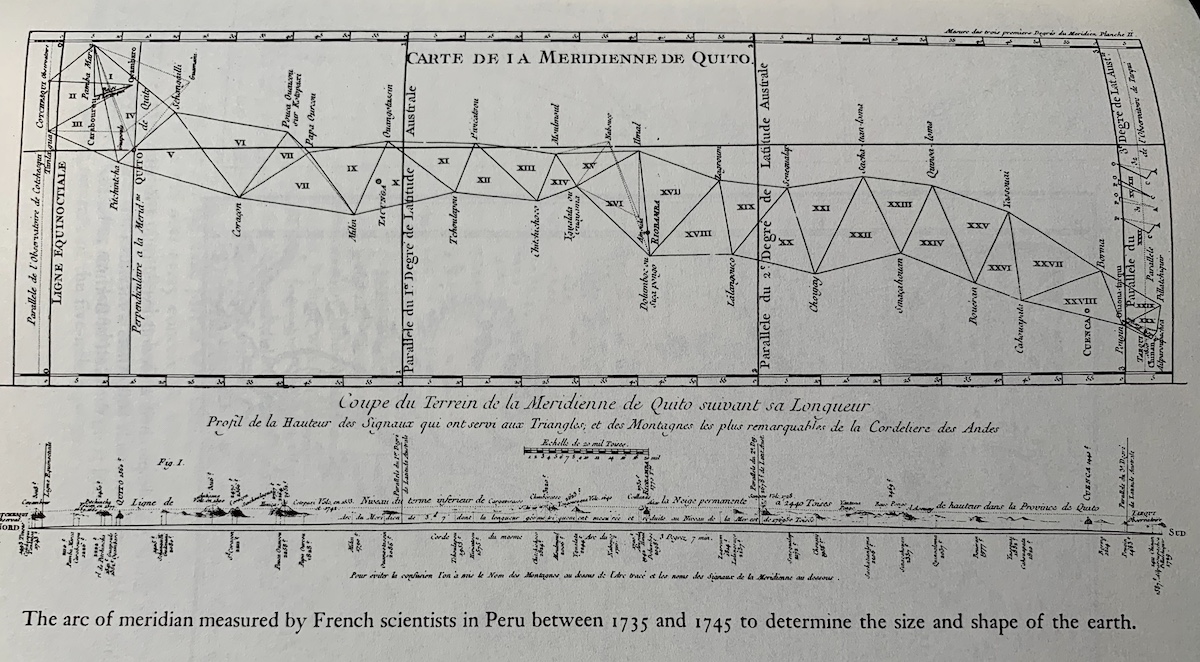
Even in the modern era, for many decades governments were the only entities capable of bringing to bear the resources to map countries or continents. Today it’s easy to discount the monumental effort required to create a map of an entire country, since we have hyper-large-scale data accessible on our phones and watches. But for most of human history, knowing a place meant putting feet on the ground there. As late as the Second World War this was how mapping was done. Here’s Brown on the Allied strategy for gaining an edge on the Axis:
The fundamental data in many cases were not to be had by gift, theft, or purchase. A map is no better than the sources from which it is compiled, and too often the sources were not to be had, at least so far as the Allied nations were concerned. No amount of synthesis, scientific or artistic, no amount of high-speed printing on fine paper could remedy the fundamental lack, the basic objective of cartography — an accurate survey of the ground.
At the time of the book’s publishing (1949), the author couldn’t have imagined the world we live in now. Near the end, Brown sums up the current state of mapmaking as one driven by government bureaus and the post-war surge in the number of skilled surveyors, newly-minted after years of investment in the effort to supply mapping intelligence to warring nations around the world. Since the 1960s, the world of mapping has been propelled by the Space Age — from U-2 spy planes and Corona satellites during the Cold War to the Key Hole program that began for reconnaissance purposes and kickstarted the commercial satellite industry. While governments and militaries are still enormous contributors to Earth sciences and geography, private enterprise has taken the mantle of cutting-edge map data collection. All of us consume maps as a default behavior today, geotagging pictures, navigating with turn-by-turn directions, and searching for the next restaurant to visit happen as a matter of course. Machines are gathering data at a rate we aren’t even able to consume. For thousands of years, people were content if the could know only the physical space. Today physical geography is seen largely as a “solved” problem. We’re now able to map human movement patterns, financial transactions, weather, wildlife, events, and anything else that happens in space and time.
The bibliography is a treasure trove of further historical works. I still have to parse through it and flag other books that look interesting for further reading.
The one major critique I have of the book is its encyclopedic depth. If it were written today, much of the excruciating detail would be left on the cutting room floor, probably, but it’s bearable once your expectations are set. For certain elements of the history, I actually welcomed the level of detail. It prevented me from having to do further Googling to dig in on the parts I was more interested in. But quite a bit of it is unnecessary belabored.
I highly recommended The Story of Maps to the geographer with an interest in history. I haven’t found a better resource that starts at the true beginning. Most histories of science or cartography won’t go all the way to Anaximander and Strabo, but Brown showed no fear in devoting 100+ pages to the foundations of the science.
This is a 92 minute 4K video taken from the International Space Station as it orbits Earth, in real-time:
If you’ve got an Apple TV and used their “Aerial” screensavers, this’ll look familiar. Most of those ones are drone footage or other things close to the ground, but recently they’ve got a couple done from space. This one is even better, though. It’s mesmerizing to see how small everything looks from this perspective, with no borders or “human” landscapes. Just the Earth and its natural chaos and beauty.
Jason Kottke has a number of other similar videos of meditative scenes like 10 hours of island sounds, an Arctic icebreaker, and a live feed from the front of a frieght train.
The team from Planet, maker of microsatellites for remote sensing, shared this set of images taken by their SkySat constellation. As this technology advances, it’s going be a phenomenal resource to make high-accuracy 3D models of cities and terrain.
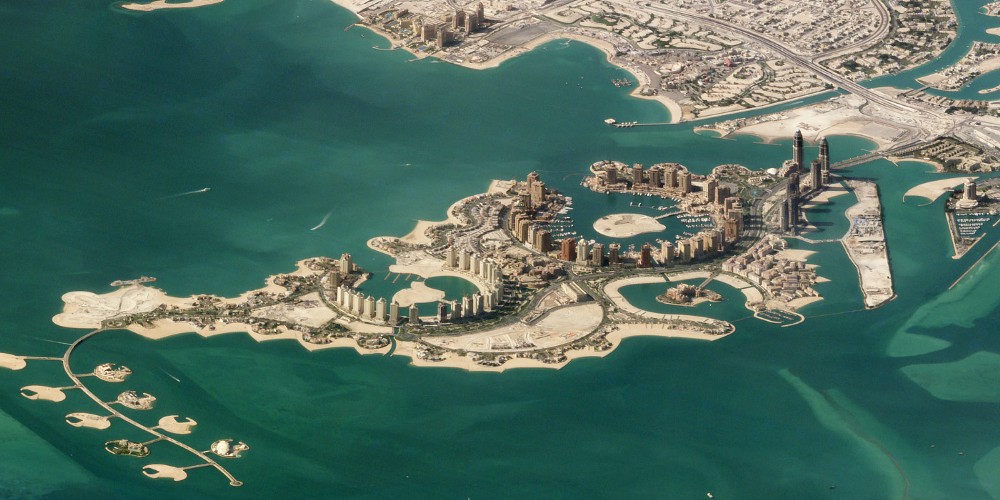
I love browsing Google Earth and looking at massive elevation differentials and escarpments like Yosemite or like Auyán Tepui, the tabletop mountain best known for Angel Falls:
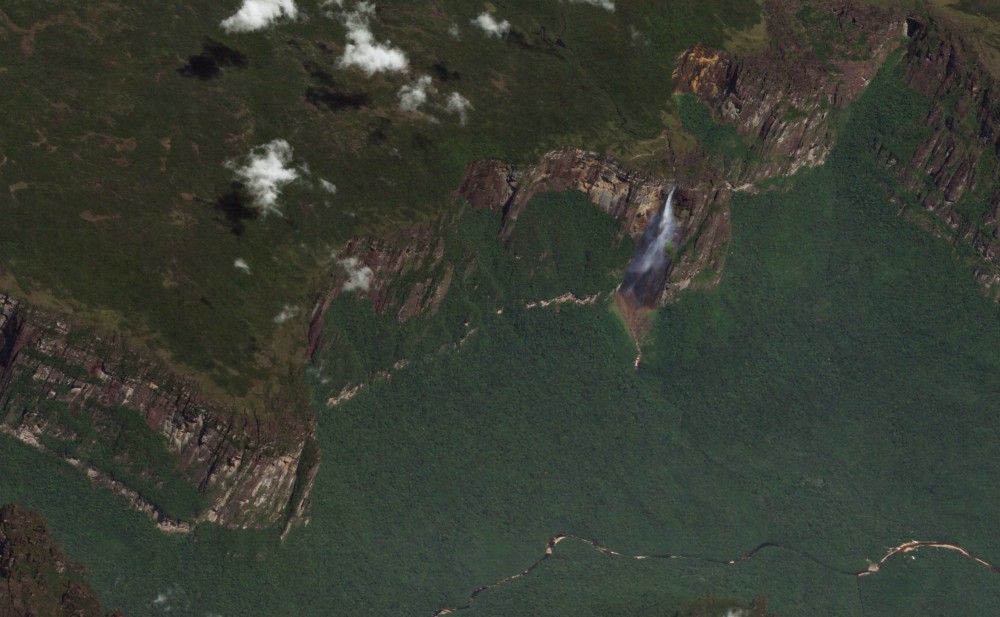
Another great cartographic analysis from Justin O’Beirne, this time on the latest updates to Apple Maps. Their new data and styling covers mostly northern California, and has some gorgeous computer-extracted natural land cover, derived from satellite imagery. The golf courses look particularly impressive:
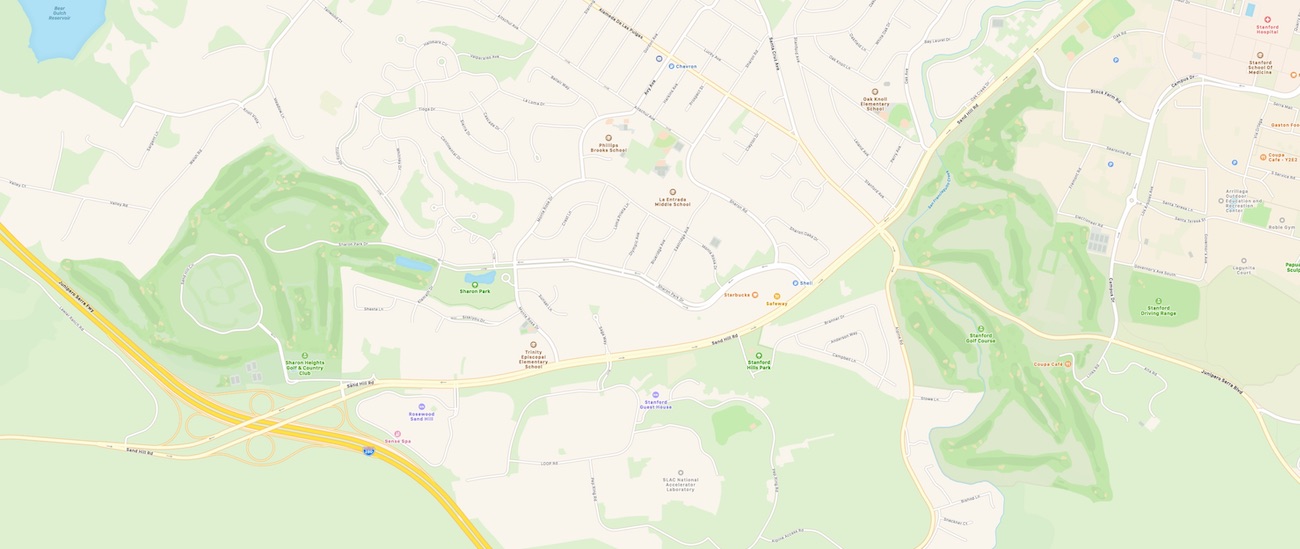
But even ignoring Apple’s competitiveness with Google, Apple’s inferior place database also impacts its own stated ambitions in augmented reality (AR) and autonomous vehicles (AVs)—both of which heavily rely on accurate and comprehensive place information.
Most of the analysis digs into how they might be deriving this new data: some algorithmically, but some through manual human extraction. The most interesting bits, though, are comparison’s to where Apple sits relative to their competition (Google) on preparedness for the world of automated vehicles. With the changes Apple and Google are making to their products, it seems Google is headed in the direction of human-oriented map data (“where do you want to go?”) versus the type of data required in getting there (“what’s the next turn?”). Of course the latter category will gradually become obsolete as machines take over the process of navigation.
Unless they’re already listed on Yelp, none of the shapes Apple has added appear in its search results or are labeled on its map. And this is a problem for Apple because AR is all about labels—but Apple’s new map is all about shapes.
So is Apple making the right map?
I’ve been collecting paper maps for years. It’s one of the few collection habits I’ve allowed myself to keep (well, including books). Some time back I wanted to inventory all of them. So I built an app in Fulcrum to log the title, source, publishing date, and photos of each.
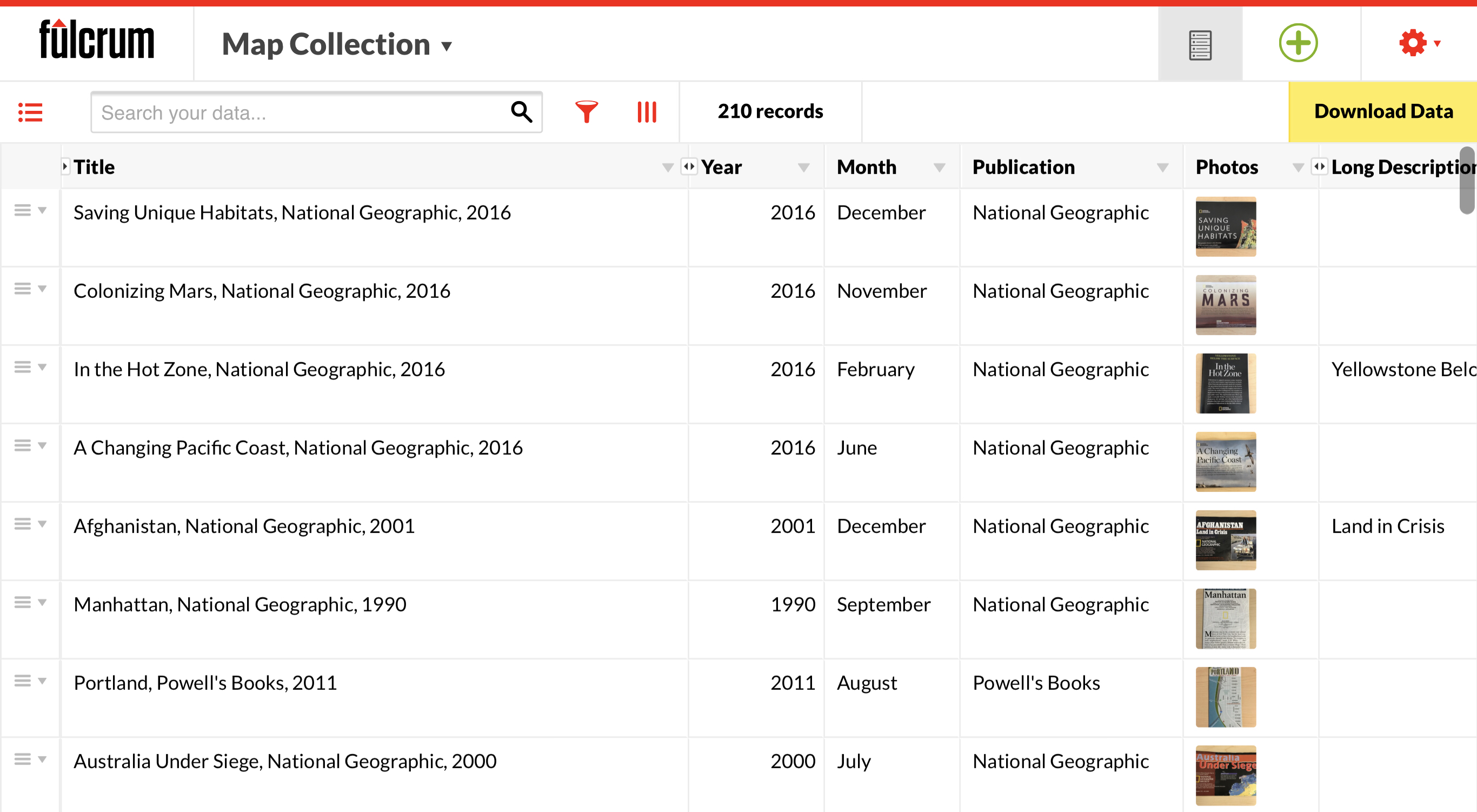
My collection’s up to 210 now. I’m working on a way to publish this. The other similar app I built a while back is a “map of maps”, basically a similar structure to my collection, but actually geotagging out in the world where I run across maps — park signage, street areas, outdoor mall floor plans, transit maps, and the like. I should set up a Fulcrum Community project to share out for folks to help build the ultimate map of public maps.
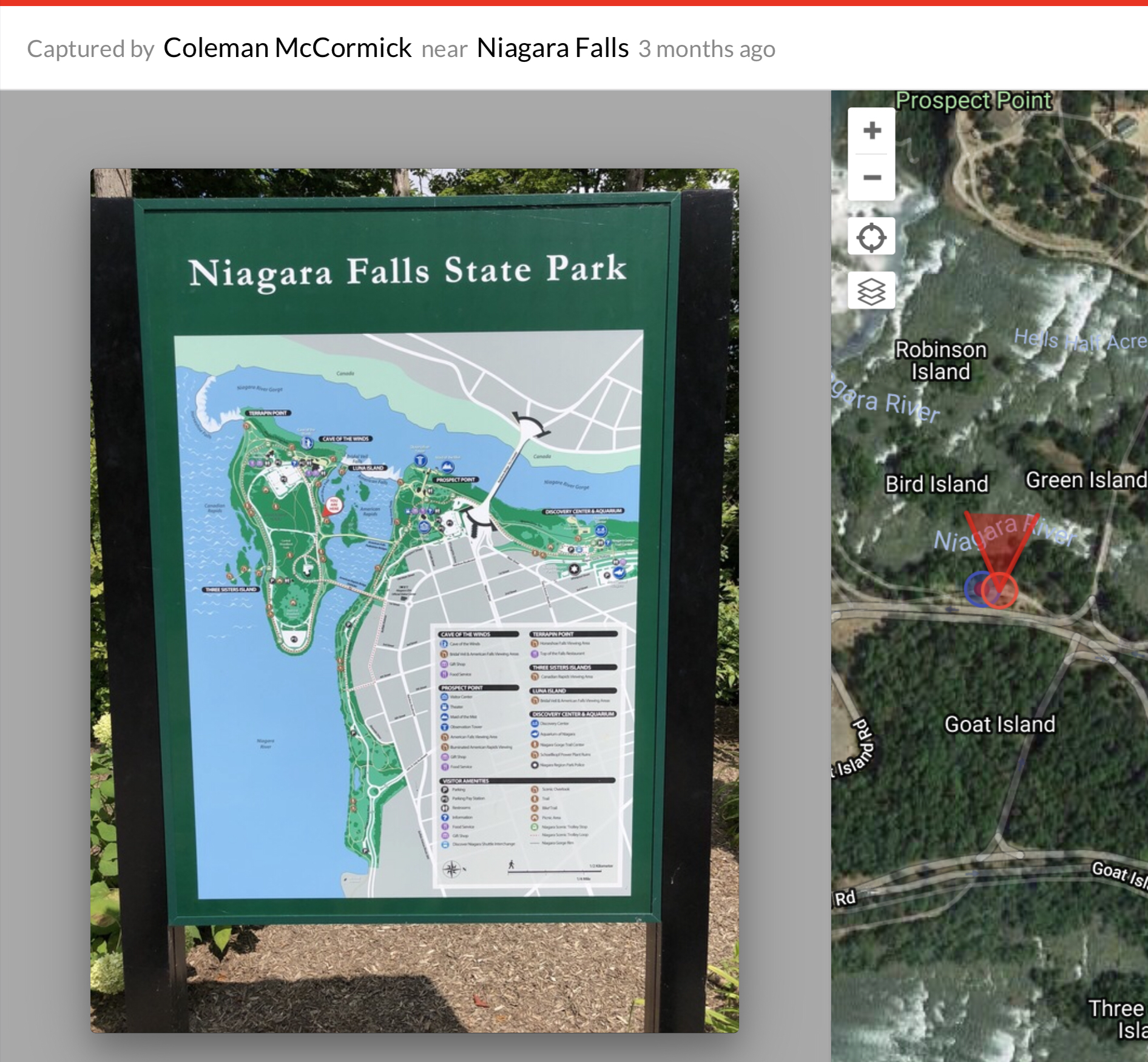
This is amazing work by Google putting air quality sensors on their Street View cars to collect air quality data. The resolution of this is amazing — to see how drastically the pollutant level changes from street to street.
I love Ryan Singer’s perspective on product development. In this post he levels critique at the now-commonplace “agile” software development process. It’s been distorted into a simplistic set of tactical process methods (building in “cycles”), and has lost what its original value was as an upgrade from the old school “waterfall” approach.
Agile became synonymous with speed. Everybody wants more, faster. And one thing most teams aren’t doing fast enough is shipping. So cycles became “sprints” and the metric of success, “velocity.”
But speed isn’t the problem. And cycles alone don’t help you ship. The problems are doing the wrong things, building to specs, and getting distracted.
Bandcamp’s blog is one of my favorite places to find new music these days. They do an excellent job surfacing the interesting things from the community and featuring them like this. Must be some real music nerds over there; just browse their blog post titles and see what I mean.
An excellent, extremely detailed analysis from Justin O’Bierne on how maps and cartography might evolve if autonomous vehicles negate our need for turn-by-turn navigation.
We can’t apply today’s maps to tomorrow’s cars – but this is exactly what those who think cartography is dying are doing. (It’s not that we’ll no longer be navigating, it’s that we’ll be navigating different things – and we’ll need new kinds of maps to help us.)
Brian Timoney’s done some great writing on this topic over the last few years. In the GIS world, enormous amounts of money are spent by governments to build and host map portals. The goals are typically noble (transparency, openness, providing access to citizens), but the results are mixed. Much of the spend is in making the information interactive. The dirty secret is that people don’t actually interact with these maps. He proposes a number of ideas of how to get the best of both: lower costs to create with the same (or higher) consumer engagement. For example, static maps cost much less to create and could even do better at directing a reader to the right information:
Just because you’re publishing a map to the web, doesn’t mean it has to be a web map. If a user is only going to spend 10-15 seconds with your map without interacting, why spend two weeks wrestling with your Javascript? And the great thing is the focus a static map brings–a single view, a single story: don’t bury the lede.
Jerry Chen from Greylock thinks “systems of intelligence” will be the next business model for software companies to create defensible value. He differentiates “systems of record” and “systems of engagement” as two layers in a stack of software applications that have existed since the dawn of the IT revolution in the 1990s.
These AI-driven systems of intelligence present a huge opportunity for new startups. Successful companies here can build a virtuous cycle of data because the more data you generate and train on with your product, the better your models become and the better your product becomes. Ultimately the product becomes tailored for each customer which creates another moat, high switching costs.
At work we’ve been building an integration between Fulcrum and DroneDeploy, a service for automating drone flight and data capture for aerial imagery. It’s compatible with the Mavic, so I gave it a shot with some test flights over my house.
The idea is simple: use DroneDeploy to draw on a map the area you want to survey from above, and their app handles building the flight plan, sending it to the drone, and flying the waypoints to take all the photos. You then take the pictures from the drone’s storage and upload to your DroneDeploy project for processing. It stitches them into a single mosaic and does a few other data processing functions to give you maps of NDVI plant health, elevation, and even a 3D model of the scene.
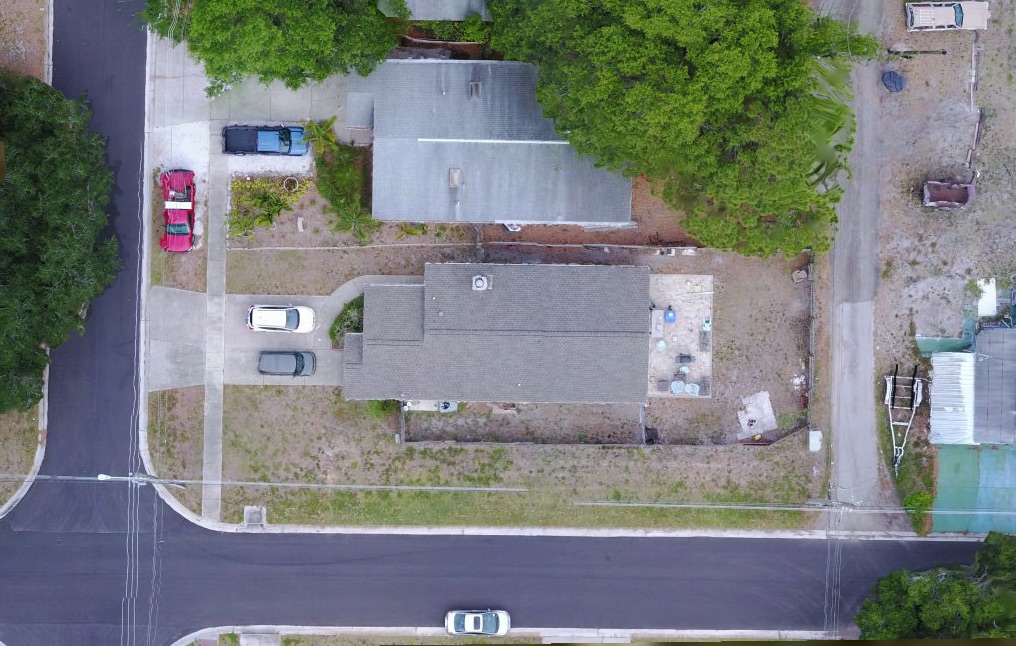
This data is from a 3 minute flight over my house at about 150 feet. The post-processed scene reports 0.75 acres at 0.6 in/pixel resolution. Only 13 stills required to create this image. It’s pretty impressive for a few minutes of setup and a few minutes of flying. In the full-res images you can actually see Elyse and I clearly standing in the backyard. She was a little spooked as it took off, but loved the landing!
Using Amazon’s Athena service, you can now interactively query OpenStreetMap data right from an interactive console. No need to use the complicated OSM API, this is pure SQL. I’ve taken a stab at building out a replica OSM database before and it’s a beast. The dataset now clocks in at 56 GB zipped. This post from Seth Fitzsimmons gives a great overview of what you can do with it:
Working with “the planet” (as the data archives are referred to) can be unwieldy. Because it contains data spanning the entire world, the size of a single archive is on the order of 50 GB. The format is bespoke and extremely specific to OSM. The data is incredibly rich, interesting, and useful, but the size, format, and tooling can often make it very difficult to even start the process of asking complex questions.
Heavy users of OSM data typically download the raw data and import it into their own systems, tailored for their individual use cases, such as map rendering, driving directions, or general analysis. Now that OSM data is available in the Apache ORC format on Amazon S3, it’s possible to query the data using Athena without even downloading it.
Personal plug here, this is something that’s been in the works for months. We just launched Editor, the completely overhauled data editing toolset in Fulcrum. I can’t wait for the follow up post to explain the nuts and bolts of how this is put together. The power and flexibility is truly amazing.
The team at DroneDeploy just launched the first live aerial imagery product for drones. Pilots can now fly imagery and get a live, processed, mosaicked result right on a tablet immediately when their mission is completed. This is truly next level stuff for the burgeoning drone market:
The poor connectivity and slow internet speeds that have long posed a challenge for mapping in remote areas don’t hamper Fieldscanner. Designed for use the fields, Fieldscanner can operate entirely offline, with no need for cellular or data coverage. Fieldscanner uses DroneDeploy’s existing automatic flight planning for DJI drones and adds local processing on the drone and mobile device to create a low-resolution Fieldscan as the drone is flying, instead of requiring you to process imagery into a map at a computer after the flight.
I bought a Mavic Pro a couple weeks ago and just got a chance to take my first flights this past weekend. In short, it’s the most impressive technology product I’ve used in years. I’ve never owned any drone, so this is pretty cool for someone in the mapping industry. Let’s dive in.

Since going out to fly aerial mapping missions with some partners of ours a couple months back, I wanted to buy one of DJI’s drones — either the larger Phantom 4 Pro, or the smaller Mavic. Extensive research led me to the portability and almost-equivalent technical specs of the Mavic over the P4. It’s so close in most of its capabilities, but the compactness of it is remarkable. I got the kit with the carrying bag, and it’s so small you could literally take it anywhere. I love the prospect of having this as a photography platform while traveling.
I did my first test flight in the backyard, plopped it down on the patio and kicked on the drone and remote control. Everything linked up right away and the DJI Go app was “Ready to Fly”. It’s so simple it seems like you’re doing something wrong. It feels like there should be more configuration. As long as you’ve got a clear GPS signal and you’re in “beginner” mode, you can just take off.
My first reaction was how easy it is to fly. You don’t have to do anything and the drone just hovers. Let go of the controls at any time and it stays put. The controller sensitivity feels smooth and intuitive; I was strafing sideways, rotating, and descending to create cool sweeping shots within 2 minutes. With a little practice you could do pro-level photography with this. Landing was just as easy: you descend where you want to land and as you approach the ground the drone halts at about 18” using its collision detection sensors. With another long hold on the left stick, it initiates the landing sequence and slowly touches down. I also tried the “Return to Home” feature, which is enabled as long as you let the drone get a good locked home location before takeoff. It’s so cool to see it work. The drone can be away from you and when you tap Return to Home on the app, the drone comes home and makes a smooth and careful landing. In a couple of tests it came home and landed in a 5-10 foot radius from the takeoff point.
Next is the software. The DJI Go app is what you use when you dock your device with the controller to get the live video, heads-up display, and settings controls, and it’s an amazing piece of software. I hadn’t used earlier versions, but in version 4, you can control everything from the app. The video feed from the drone and the HUD view of all the needed metrics looks great (altitude, bearing, distance). Triggers on the sides of the remote snap photos and start recording video. DJI has honed the system down to the simplicity of a video game. I’ve only done a couple of flights, but the video and photo quality is excellent. 4K video from this tiny airframe and camera is a stunning feat.
One of my flights was in about 15 knot winds, and the little guy held up well. The camera’s gimbal was rock steady even in breezy conditions. I noticed a tiny bit of jitter when flying into the teeth of the wind, but not enough to make a difference. I flew one mission of aerial imagery with DroneDeploy, but will dive deeper on that in a future post when I can do more flights.
A few other things on the docket to try:
There’s been a boom in the last couple years of big tech companies trying to reach to the periphery of the globe and bring Internet access to people without connectivity. Facebook is launching giant solar-powered drones with lasers, Google is floating balloons with antennae into the stratosphere, and smartphones are cheaper than ever.
The success rate of these projects is hard to quantify, it’s too early. But for the mapping industry, it’s a fact that billions of people don’t have access to the kinds of map data we have in the US or Europe, and the immaturity of infrastructure and public services like managed street addresses and quality map data are holding back the advance of mobile location-based services. E-commerce companies like Amazon and logistics providers like UPS and FedEx rely on quality geographic data to conduct business. Cities like Lagos, Dhaka, or Kinshasa are enormous booming urban centers, but still don’t have reliable addressing systems for navigating city streets.

Given the combination of expanding connectivity to disconnected places and the vacuum of reliable geodata, a number of services have sprung up in recent years with systems for global wayfinding and geocoding. The particular focus here is to bring a mechanism for providing addresses to places where there are no other alternatives. When I first read that people were building new systems for geocoding it piqued my interest, so I dug into them to see what they’re all about, and what they might be bringing to the table that we don’t already have.
The first step in understanding the problem at hand is to lay down some definitions that differentiate an “address” from a “coordinate”. An address is an identifier for a place where a person, organization, or the like is located or can be found, while a coordinate is a group of numbers used to indicate position in space.
This fundamental difference is important because addresses only truly matter where there are people, but coordinates are universal identifiers for anywhere on the globe. A location in the center of the North Atlantic has a position in any global geographic coordinate system, but having a human-readable address isn’t important; it’s unnecessary for everyday use. Coordinate or grid systems can function as addresses, but the reverse isn’t always the case.
I thought I’d compare some different geocoding systems to see where the pros and cons are. Are they really necessary, or can we make use of existing proliferated systems without reinventing this wheel?
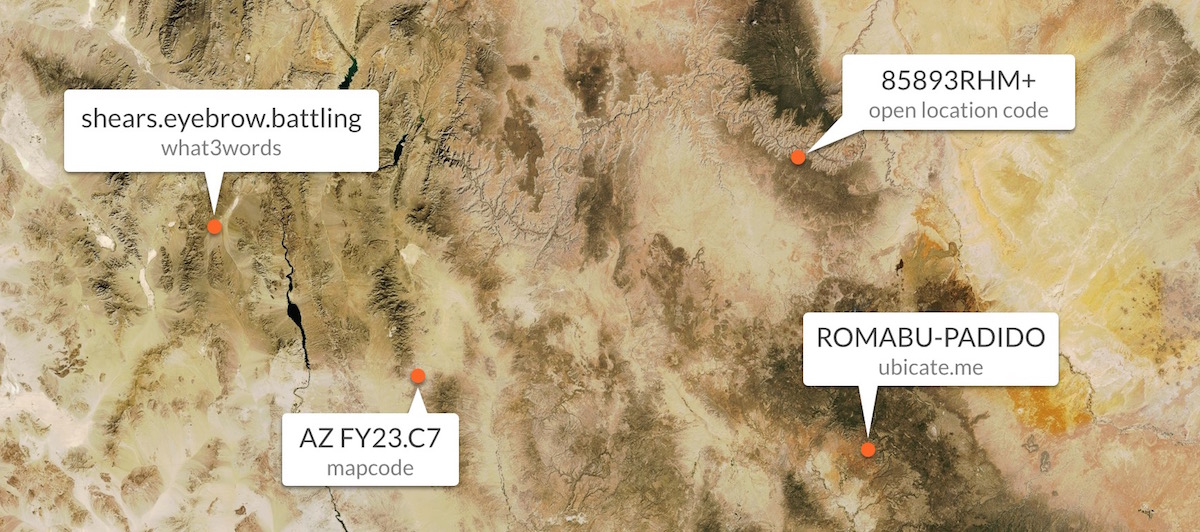
These systems all provide similar capabilities, with a primary focus of providing memorable human-friendly identifiers for places. There are others out there in the wild, but I’ll just talk about some of the prominent ones I’ve run across:
Each of these geocoding services have similar sets of objectives: to make addresses derivable for anywhere on Earth using algorithms, assign shorter and more memorable codes than coordinate systems or postal codes, and to have codes that reduce ambiguity (not contain “O” and “0”, or by using distinctly different words and phrases). The interesting thing with all of them is that by deriving coordinates deterministically, the result can be controlled and forcefully made more human-friendly. In the case of what3words, it generates shorter and more memorable word combinations in areas with higher population density. So lives.magma.palace will take you to Philadelphia’s Independence Hall, while conservatory.thrashing.incinerated will get you to the remote Arctic islands of Svalbard. This is a clever method to optimize the pool of words for usage frequency, and obviously not something that can be controlled with traditional coordinate systems.
Algorithmic systems can also allow a user to shorten the code for a less granular location. With OLC, you can knock off the last couple characters and get a larger area containing the original location. 76VVQ9C6+ encompasses the few city blocks around our building. 76VVQ9C6+9M gets you right to my office. Because it represents an area rather than only a point, truncating to get successively larger areas is possible. Truncating a lat/lon coordinate moves the point entirely.
The what3words approach seems the most creative and truly memorable method, though it sounds sort of gimmicky. They’ve done a lot to accommodate for things like offensive words, avoiding homophones, removing ambiguous combinations, and even providing the system in several languages.
Spreading adoption for any of these systems will be an enormous challenge. They all seem to be different varieties of the same wheel. If I was developing mapping applications, which system should I support? All of them? Software developers will have to buy into one or more new systems and users will have to understand how they work.
Another issue is one of ownership. If a new scheme for addressing requires a special algorithm or code library for calculating coordinates, it should be in the public domain and serve as an open standard (if anyone expects adoption to grow). In the age of open source, no platform developer is going to license a proprietary system for generating coordinates with so many open alternatives out there. Both OLC and Mapcodes have an open license, but what3words is currently proprietary.
Let’s compare these tools to what existing coordinate schemes we already have.

Addresses in the classic sense of “123 Main St” make sense for navigation, particularly due to a hundred years of usage and understanding. When I’m searching for “372 Woodlawn Court” in my car, there are some conventions about addressing that help me get there without knowing specific geographic coordinates–odd numbers are on one side and even on the other, numbers follow a sequence in a specific direction–so people can still do some of the wayfinding themselves. Naturally this is reliant on having a trusted, known address format, but nonetheless, adoption of new geocoding systems should be valuable for everyone, not just in places without modern address systems.
How do new means of addressing physical space stack up to the pre-existing constructs we’ve had for decades (or centuries)? Do the benefits outweigh the costs of adopting something new?
Here are several of the common coordinate systems used globally for navigation and mapping:
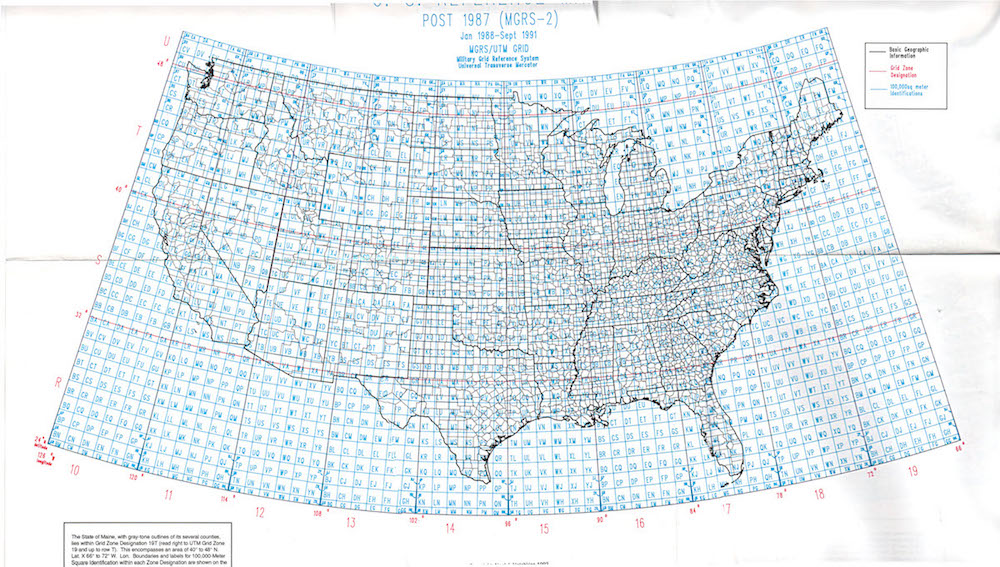
These systems have some distinct advantages over building something new (and naturally some disadvantages). But I think the gains had with algorithmic libraries and services like those mentioned above aren’t enough to warrant convincing millions of people to adopt something new.
If you look back at the primary benefits of Open Location Codes or what3words, it’s memorability. I’ll grant that what3words has a leg up in this department, but the others, not so much. Is 17RLL3861573116 really that much worse than 76VVQ9F6+4V? Neither are very human-friendly to me, but at least something like MGRS has a worldwide existing base of understanding, users, and tools supporting it.
I would concede that memorability and reduced ambiguity could help to replicate the ease-of-use we get with classic addresses. But in the days of ubiquitous GPS, smartphones, and apps, people don’t realistically memorize anything about location anymore. We punch everything into a mapping app or the in-car navigation system. Given that, what benefit are we left with inventing a new system of expressing location?
I think it’s wise to spread adoption of widespread systems like MGRS or UTM before we start asking citizens of developing countries to adopt systems that no one else is using yet, even if those systems do come with some new benefits.
If you’re interested in reading more background on some of these systems, check out these links:
The concept of activity tracking is getting ever closer to ubiquitous nowadays with the prevalence of dozens of mobile apps, wearable wristbands, and other health monitoring tools like Bluetooth-enabled scales and video games based on exercise. Now the world’s largest tech company is even rumored to be working on some form of wearable hardware (and software APIs), at which point the whole concept of “life tracking” will reach 100% penetration. Everyone will be tracking and recording their lives like characters in cyberpunk literature.
I’m a casual runner and cyclist, and started testing a handful of fitness tracker mobile apps to map my activity. Since I’m a stats and data junkie, I did some extensive experimental testing with these four apps to size up the advantages of each in terms of technical capability, as well as the feature-set of services provided by each within their online social systems:
There are dozens of other options for wearable hardware for tracking activity, location, and more, but I still think most of them are either too costly or not mature enough to invest my money in. I seriously debated buying a Fitbit or Up, but I’m glad I haven’t given Apple’s potential push into that market.
Let’s run through the details of each and compare what they have to offer.
Each of these apps has its focus, but they all promise the same basic set of features (with the exception of Moves, which I’ll get to in a moment):
Moves is a different style of app. It’s a persistent motion tracker that runs continuously in the background on your device, mostly for calculating steps and distance per day for all of your activity. No need to open the app and record independent activities. I wanted to include Moves in the mix primarily for its deep data recording and mapping capabilities. I’ll revisit Moves’ data quality later on when discussing data.
I’m an iPhone user, and iOS has matured to the point that serious, veteran app developers have ironed out most of the annoyances and kinks of basic app design concepts. Most of the conventions around app UI have arrived at general consensus in presentation, using a couple of well-known paradigms for structuring the user interface. Both RunKeeper and Strava use the home-row tab button UI layout, with standard “5-button” options list across the bottom. MapMyRun uses the sidebar/tray strategy to house its options, like most of Google’s iOS apps.
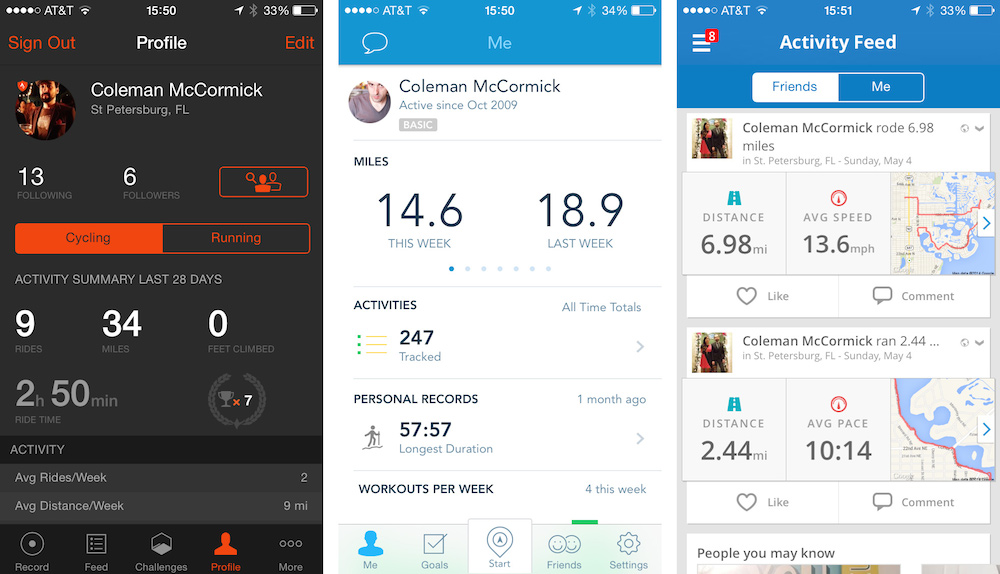
The basic interfaces of all three of these apps are nice. RunKeeper and Strava are almost exactly level on features on the mobile side. They both have a basic social presence or feed of your friends’ activity, activity type selectors, and big “Start” buttons to get going with minimal fiddling. MMR’s look is a little cluttered for me, but it does include other functions on the mobile side like weight entry and nutrition logging.
All of them support configurable audio announcements of progress during an activity. A voice will chime in while you’re running to give you reports on your current distance, pace, and time since the start. Each also can be paired up via Bluetooth with an array of external sensors like heart rate monitors, bike speedometers, and others. Strava even has a nice capability to visualize your heart rate metrics throughout the course of your activities if you use a monitor.
In my testing, the reliability and consistency of all of these apps has come a long way since the early days of the App Store, back to iPhone 3G and the first devices with GPS. The only one of the group that I’ve been using that long (since 2009) is RunKeeper, and its reliability now is in another class than it was back then. Since the introduction of multitasking with iOS, apps run silently in the background when switching between apps while a tracking activity is in progress. I tested tracking with all three simultaneously without any issues.
During a couple of my test runs, Strava inexplicably stopped my activity for no reason, but didn’t hard crash. When I’d switch back to the app, the current activity was paused mid-way, which is an annoying bug or behavior to encounter when you can’t recreate your activity easily. RunKeeper still seems the most reliable option all around, including the mobile app dependability and the syncing operations with the cloud service. Multiple times I had trouble getting the activity to properly save and sync on Strava and MapMyRun, though usually it was just a delay in being able to get my data synced — didn’t involve data loss except for the paused activities and couple of app crashes.
All three of these apps function as clients for their associated web services, not just standalone applications. They’re not much different; each of them shows a feed of activity and a way to browse your (and your friends’) activity details. Stacking up your accomplishments against your friends for some friendly competition seems to be the main focus of their web services, but the motivators and ability to “plus up” friends’ activity might push some to work out harder or more often. The differences here are mostly minor, and deciding on the “best” service in terms of its online offerings will come down to personal preference. One of the features I like with Strava is the ability to add equipment that you use, like your running shoes or specific bikes. Doing this will let you see the total distance ridden on your bike over time.
Each service offers a premium paid tier with additional features. Strava and RunKeeper have free-to-use mobile apps with fewer features, while MMR goes with advertisements and in-app-purchase to remove the ads.
My primary interest in analyzing these services was to check out the quality of the GPS data logging. I ran all three of them on the same ride through Snell Isle so I could overlay them together and see what the variance was in location accuracy. Even though iOS is ultimately logging the same data from the same sensor, and offering that up to the applications via the Core Location API, the data shows that all three apps must be processing and storing the location values differently. Here’s a map showing the GPS track lines recorded in each — Strava, MapMyRun, and RunKeeper. Click the buttons below the map to toggle them on and off to see how the geometry compares. If you zoom in close, you’ll see the lines stray apart in some areas.
Each app performs roughly the same in terms of location data quality. The small variances in precision seem to trend together for the most part, which makes sense. When the signal gets bad, or the sky is slightly occluded, the Location APIs are going to return worse data for all running applications. One noticable difference between the track geometry (in this example, at least) is that the MapMyRun track alignment tends to vary in different ways than the other two. It looks like there might be some sort of server-side smoothing or splining going on to make the data look better after processing, but it doesn’t dramatically change the accuracy of the data overall.
I did notice that using these apps without cellular data enabled results in severe degradation of quality, I think due to the fact that the Assisted GPS services are unavailable, forcing the phone to rely on a raw GPS satellite fix. When using any location logging app without cellular data switched on, the device has to take longer to get a position lock. A couple of runs from my Europe trip exhibited this, like my run along the Thames in London, and one in Lucerne.
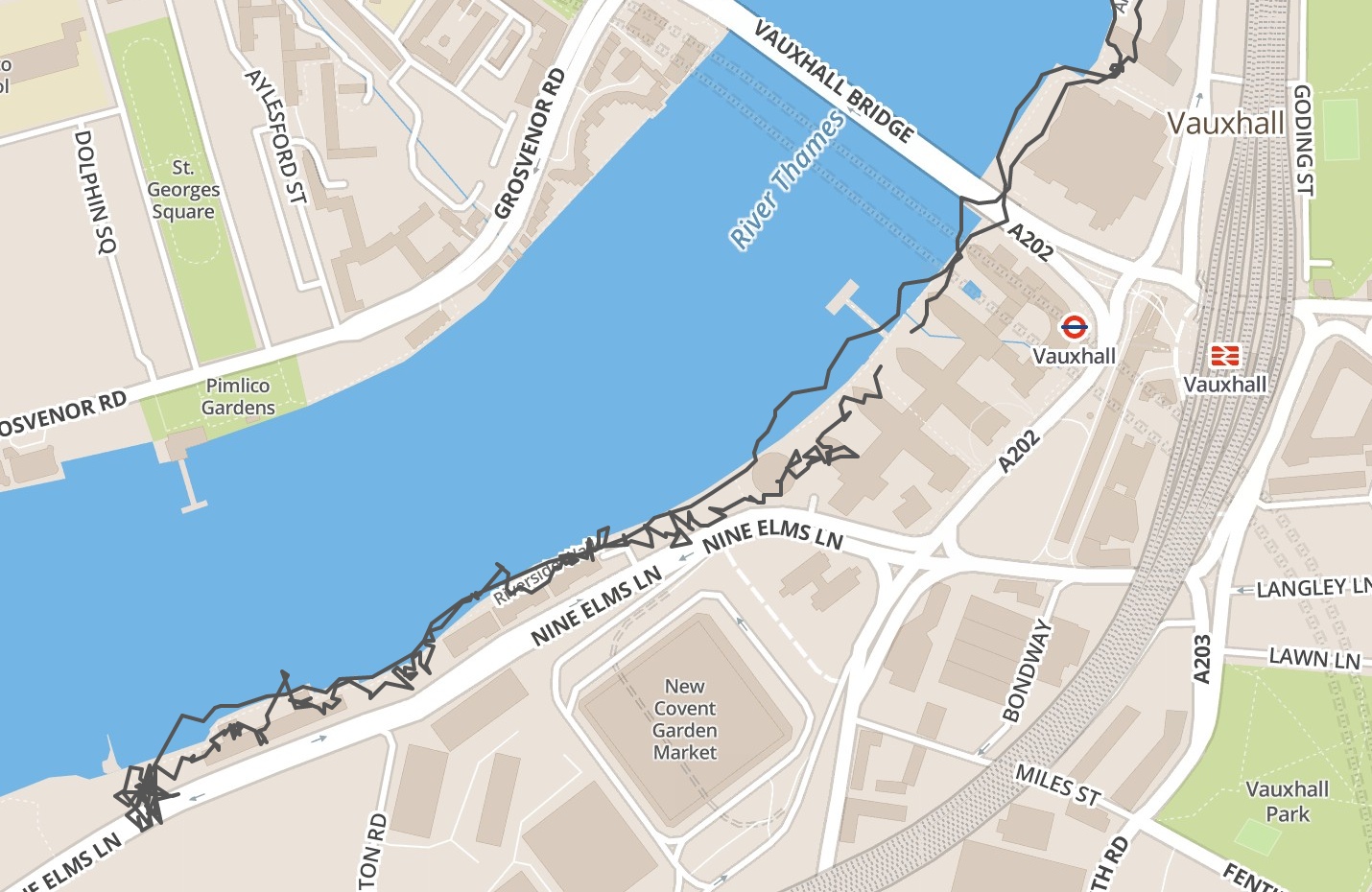
Since these motion trackers rely on the GPS track and time series data for calculating total distance (which is obviously way off with this much linear error), you end up with massively incorrect pace and calorie-burning metrics. This jagged-looking run activity in London reported itself to be 4.7 miles, and in reality it was only about 3.5. Soon I’d like to pair my iPhone up with an external GPS device I’ve been testing out to see what the improvement in accuracy looks like.
If you want to export the raw data straight from the web services, Strava and RunKeeper are the only ones that will give you a full time series-enabled GPX track file for each activity. MapMyRun only exports the track point data, which without the timestamp info for each point can’t be processed to calculate pace and other metrics with elapsed time as a variable.
The location data captured by the Moves app works a little differently. It splits your persistent movement activity up into day and week views, with totals of steps taken and calories burned, by type of activity. It does some cool auto-detection of activity type to try and classify car transport, cycling, running, and walking automatically. Because it’s always running in the background, though, the location data isn’t quite as granular as from the other three applications, probably due to less frequent logging using the location APIs.

One caveat important to note is that Moves was acquired by Facebook back in May. That may turn a lot of people off to the idea of uploading their persistent motion tracking information to the Borg.
Strava and MapMyRun also support pulling the track info from external devices like mountable GPS devices, watches, and bike sensors.
Overall, my favorite is Strava as the app-of-choice for tracking activity. It performs consistently, the GPS and fitness data is high quality, and the service has a good balance of simplicity and social features that I like.
I wrote a blog post last week about the first few months of usage of Pushpin, the mobile app we built for editing OpenStreetMap data.
As I mentioned in the post, I’m fascinated and excited by how many brand new OpenStreetMap users we’re creating, and how many who never edited before are taking an interest in making contributions. This has been an historic problem for the OpenStreetMap project for years now: How do you convince a casually-interested person to invest the time to learn how to contribute themselves?
There are two primary hurdles I’ve always seen with why “interested users” don’t make contributions; one technical, and one more philosophical:
To the first point, this is an issue largely of time and effort on the part of the volunteer-led developer community behind OpenStreetMap. GIS data is fundamentally complex, much moreso than Wikipedia’s content, the primary analog to which OpenStreetMap is often compared—“Wikipedia for maps”. It’s an apt comparison only on a conceptual level, but when it comes time to build an editor for the information within each system, the demands of OpenStreetMap data take the complexity to another level. As I said, the community is constantly chewing this issue, and making amazing progress on a new web-based editor. In building Pushpin, we spent a long time making sure that the user didn’t need to know anything about the complex OpenStreetMap tagging system in order to make edits. We picked apart the wiki and taginfo to abstract the common tags into simple picklists, which prevents both the need to type lots of info, and the need to know that amenity=place_of_worship is the proper tag for a church or mosque.
As for answering the “why”, that’s a little more complicated. People contribute to community projects for a host of reasons, so it’s a challenge to nail down how this should be communicated about OSM. There are stray bits around that tell the story pretty succinctly, but the problem lies in centralizing that core message. The LearnOSM site does a good job of explaining to a non-expert what the benefits are of becoming part of the contributor community, but it feels like the story needs to be told somewhere closer to the main homepage. Alex Barth recently proposed an excellent idea to the OpenStreetMap mailing list, a “contributors mark” that can be used within OSM-based services to convey the value of free and open map data. This is an excellent idea that addresses a couple of needs. For one it communicates what the project actually is, rather than just sending the unsuspecting user to a page about ODbL, and it also gives a general sense of how the data is used by real people.
In order for those one million user accounts to turn into one million contributors, we need to do a better job at conveying the meaning of the project and the value it provides to OpenStreetMap’s thousands of data consumers.
Generating a real-time topographic map with a sandbox, Kinect, and a projector.
This is the kind of thing I want to see more with augmented reality.
We’ve just posted a map of Kabul, Afghanistan built from spatial networks map data. I built this a couple of months back (with TileMill) for some mobile field collection project work we were doing with Fulcrum. This is the sort of challenging work that our company is out there doing, bringing high-tech (yet cheap and simple) solutions to up-and-coming communities like Kabul.
My talk from Ignite Spatial at WhereCampTB, talking about the OSM Tampa Bay meetup group. Check out the slides in better detail here.
It was a fun event a couple weeks ago — great participation from folks in all sorts of industries involved in mapping or using GIS tools.
We just returned from a fantastic weekend up in DC - first at the Ignite Spatial event on Friday night, then the WhereCampDC unconference on Saturday. Being the first event of it’s kind that I’ve attended (with the “barcamp” unconference session format), I thought I’d write up some thoughts and impressions from an amazing 2-day trip.
This was also my first experience hearing talks in the ignite format—20 slides, 15 seconds each, 5 minutes. A fantastic format to break people out of the habit of simply reading their slides off a screen. Held at Grosvenor Auditorium at National Geographic Society headquarters, the series was well-run, prompted and emcee’d by Nathaniel Kelso, who did a bang-up job pulling together logistics for both days Our own Tony Quartararo gave his first talk in the ignite format: Homophily and the “geoherd”, where he posited that if the theory of homophily (love of being alike) applies to the spread of human attitudes and behaviors, than it also can spread our community’s interest in geography and technology onto other social circles of people who haven’t yet been addicted to using Foursquare, editing OpenStreetMap, or contributing to open source projects. Being aware of our “three degrees of influence” can help us to spread our collective interest in geospatial technology to those that may not even be aware of such things. Vizzuality’s Javier de la Torre presented his work on the OldWeather project, a social and community-driven effort to derive century-old historical weather data by having members transcribe Royal Navy captain’s logbooks—a clever solution to acquiring loads of data about wind, water temperature, sea conditions, and shipboard events from 100 years ago. He even showed off some stunning visualizations of the data. Definitely a crowd favorite. Sophia Parafina declared that “WMS is Dead” (I agree!), Mapbox founder Eric Gundersen showed off making gorgeous maps with their TileMill map design studio, GeoIQ’s Andrew Turner demonstrated the many, many ways he bent geodata to his will to find the perfect DC house.
The unconference was held at the Washington Post office, which has a nice setup for the format and the attendance that showed up (200 people!). This was my first experience with the user-generated conference format, and I enjoyed it far more out of it than other formal conferences. It starts with the attendees proposing talks and discussions and scheduling them out in separate rooms throughout the day, then everyone breaks up into groups to drill down on whatever topics they find useful. I attend a lot of conferences with high-level discussion about GIS and the mapping community, so in this particular crowd I was more interested in deep diving on some technical discussions of open source stuff we’ve been using a lot of lately.

After meeting most of the guys from Development Seed, I knew I wanted to sit in on Tom MacWright’s talk about Wax, their Javascript toolkit to extend functionality for Modest Maps, which makes it super easy to publish maps on the web. What they’re doing with Wax will be the future of web mapping for a lot of people. Really the only open source alternative to the commercial Google Maps API at this stage is OpenLayers, which can be overly featureful, heavy, and slow for most developers who just want some simple maps on the web. Dane Springmeyer proposed a discussion around “Mapnik Visioning”, wherein we went around the room discussing the future of our favorite renderer of beautiful map tiles. Mapnik is a critical low-level platform component for generating tiles from custom data, a foundational piece of the open source web mapping puzzle, and it was refreshing to see such technical, in-depth discussion for where to go next with the Mapnik project. Takeaway: node.js and node-mapnik bindings are going to be the future of the platform. AJ Ashton spun up a discussion about TileMill, the map tile design studio that Mapbox has constructed to help cartographers make beautiful maps easily with open standards and their own custom data. TileMill has definitely added a huge capability for us to style up and distribute maps of our own data. The stack of tools that TileMill provides allows designers to create great cartography for map data quickly, and to export as a tileset for viewing on the web or mobile. TileMill has firmly planted itself in our arsenal as something we’ll continue to use for a long time, a fantastic tool for designers.

The University of Warwick campus map was drawn on foot at 1:1 scale with 238 miles of GPS tracks walked over 17 days.
I love the compass rose, scale, and signature.
For the Vancouver Olympics, the StreetView guys have been hitting the slopes to get imagery from snowmobiles. The little StreetView guy is even a skier.
Calendria is a place where units of time become sovereignties.
“The Kingdom of March, with the Equinoctial Estuary on its western coast, is situated on a separate land mass to the east of Calendria’s main continent. The Republic of Junistan is in the southeast, an archipelago among which are the Circadian Islands.”

Also see the documented process the designer used to make this gorgeous map.
A New York Times visualization of most-queued films by US zip code. A cool example of what can be done with 100% free data. The queue data is accessible through Netflix’s API and zip code boundaries from the US Census.